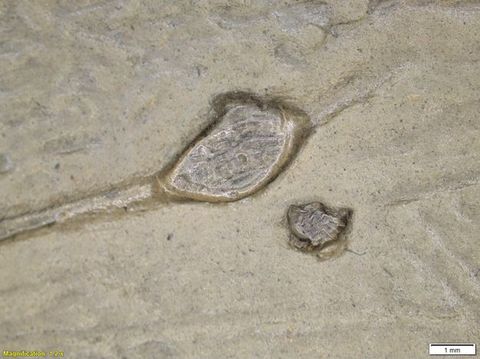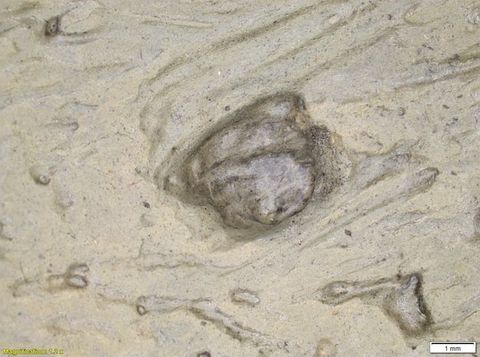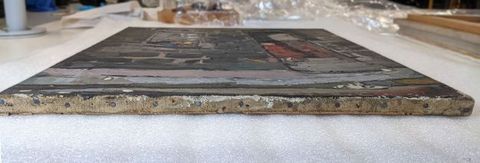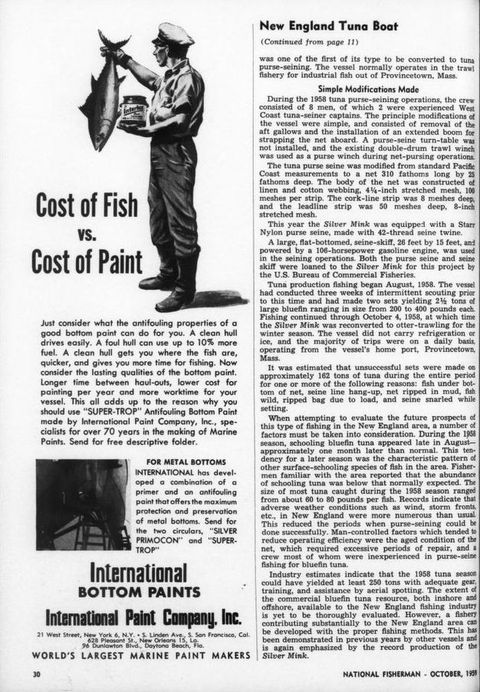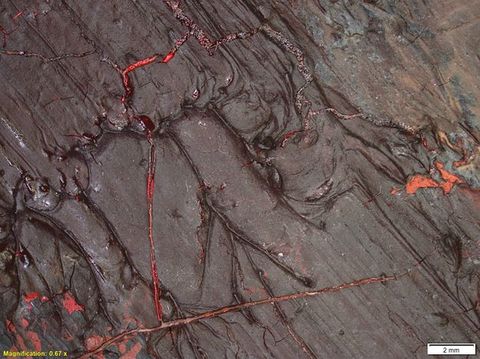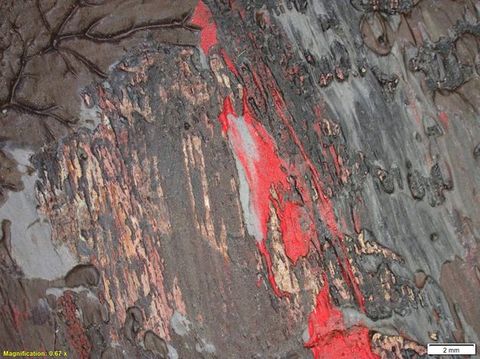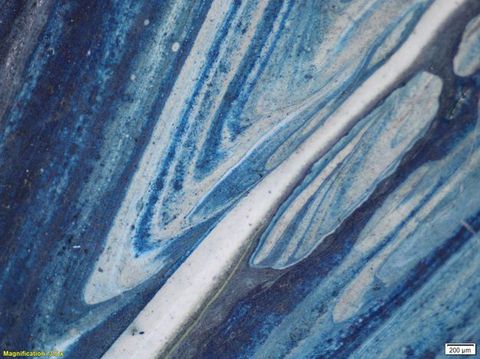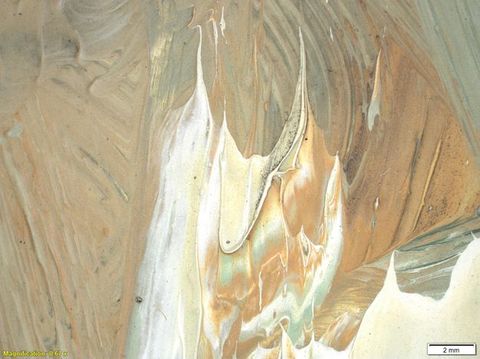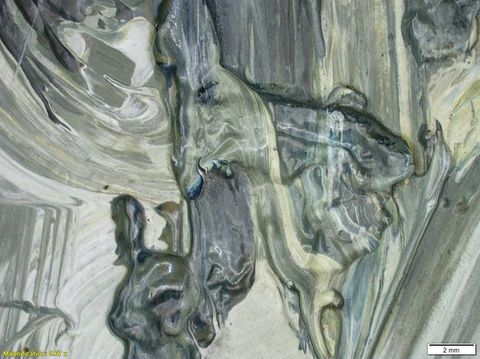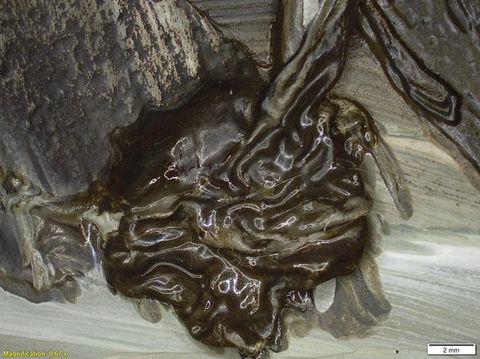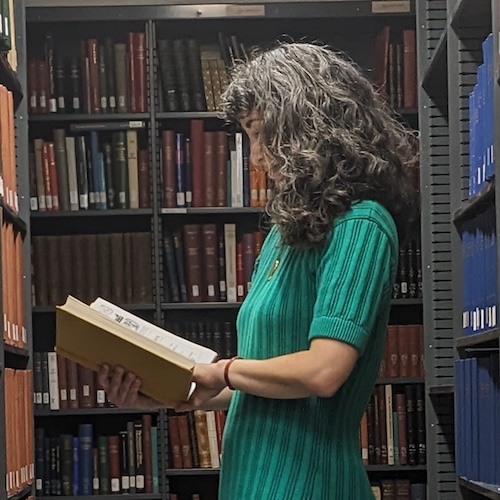Joan Eardley and the Untidy, Tidal Nature of Painting
Joan Eardley and the Untidy, Tidal Nature of Painting
By Natalie Lawler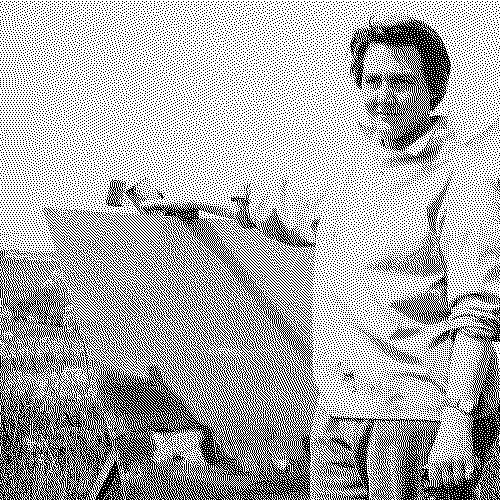
Abstract
This article combines archival research with scientific imaging and analysis to illuminate the materials and methods of Joan Eardley’s painting practice during the post-World War II period. At a time of enormous diversification in the look, feel, chemistry, and application of materials used by artists, Eardley’s toolkit blended experimentation with tradition and environmental symbiosis. From two distinct studios in Scotland—one in central Glasgow and the other in the coastal fishing village of Catterline—she wrestled a gestural language from oil paint, recycled canvases, and industrial boards that flexed with seasonal humidity or gale force winds. She is thought to have augmented her palette with house paint and boat paint. Focusing on three paintings from the Hunterian collection, this article presents a series of vignettes exploring Eardley’s studios, supplies, and paint application against the historical backdrop of art technologies in transition.
From a Material Point of View
What materials were available to a painter in 1950s Scotland? And how did she harness them?
In the shadow of a world-shattering war, an artist might use her supplies with the muscle memory of rationing and scarcity or with newfound abandon; she might prefer the comfort of the same traditional oils and canvas she has always used; she might experiment with the futuristic slick of new house paints or surfaces such as compressed-wood hardboards.
For Joan Eardley, whose painting practice matured in Scotland during the post-World War II period, all the above apply. After moving to northwest Glasgow with her mother and sister in 1940, Eardley spent most of that decade as a student at the Glasgow School of Art, with a wartime stint as an apprentice joiner at a boatyard, painting camouflage on landing craft. By 1949, she was exhibiting and selling artworks and was a professional member of the Society of Scottish Artists. Her lamentably brief career ended in 1963, when she died of breast cancer at the age of forty-two, three months after being elected to the Royal Scottish Academy.3 Eardley’s trajectory as a working painter paralleled the waning days of material rations in Britain and a global groundswell in applied sciences: throughout the 1950s, the look, feel, and chemistry of painting and building materials of all kinds were rapidly diversifying. The specialized scientific labor force, laboratories, and instruments that, during the war, had surged with funding to develop alternatives for scarce raw materials, pivoted their research to postwar commercial enterprises. Products such as synthetic resin paints or artificial construction boards used by industrial tradespeople found new markets in private consumers, including artists. Although Eardley and her peers had been trained using the long-dominant materials of European painting practice—oils and canvas—the reality of many artists’ studios was more experimental. The rising popularity of gloss house paint at the time has been especially well documented.4 Today, painting conservators consider this decade to have been the effective shifting point from “modern” to “contemporary” practices because of the sharp increase in artists’ use of nontraditional supplies.5
3Material exploration and physical rigor defined Eardley’s professional career. Throughout the 1950s, she frequently shuttled between her two studios: a dusty workshop in a Glasgow tenement, and a wind-blown shack in the village of Catterline, skirting the North Sea. Working daily, indoors or outdoors, even during blizzards, she nursed a compulsion to draw and paint from observation. Her gestural, flickering brushwork thrived on scenes of evasive, ephemeral color:
6Certainly the coldest and worst day of the year—a most exciting day too, with every variation of colour—black sea, bright green striped sea—brown sea yellow sea—and no sea … Extraordinary storm cloud formations too … I had to stick to one mood and position—when all the time I was itching to turn hither and thither.6
Eardley calmed her impatient eyes with chalk, pastel, paint, paper, canvas—each technical choice carried sensory value. She sometimes embedded elements from her immediate environment into sticky paint: newspaper, foil candy wrappers, plant matter. The few monographs and published essays on Joan Eardley include useful material details like these, but they are primarily contextualized through biography or framed as risky experiments. Eardley’s layered materials do pose significant questions about the long-term care—and, in turn, visibility—of her work. But what if they also reveal deeper nuances within the nature of postwar artistic experimentation?
This period in painting is often characterized by macroscopic boundaries such as traditional or contemporary, realism or abstraction, before or after. But, as a manual craft, painting is horizontal and sprawling—these large transitions contain much smaller, messier units of measure. From the point of view of a studio, a canvas, a pigment particle, the traditions and technologies of a painter’s daily labor are perpetually remade; her toolkit reflects local economies and the swell of global industries alike. Many accounts refer to Eardley’s use of house or boat paints, of mixing beach sand or grit into her paint, and of grinding her own pigments by hand. These details suggest diverse methods, textures, and supplies, yet they are rarely elaborated. Her artworks, like many of her archived letters, are often approximately dated, resisting a precise linear chronology.7 Eardley’s hard-won visual vocabulary seems less of a pronounced shift than a stretching, curling of painting practices, built through material trial and error, enabled by new and old technologies in tandem—a relentless tide that pushed forward as much as it pulled from what came before.
7Little is known for certain about Joan Eardley’s materials. My research is an initial step to compile, question, and record.
Leveraging archival and technical approaches, this study is the result of sustained engagement with Eardley’s paintings as primary sources. Over three months in 2021, I conducted a detailed examination of three paintings from approximately 1956–58: Glasgow Close, oil paint on re-stretched canvas; and Winter Sea III and Stacks at Evening, both oil paint on industrial hardboard (figs. 1–3). These represent each of her studios, and a range of scales, mark-making, and substrates. In affiliation with The Hunterian and the Kelvin Centre for Conservation and Cultural Heritage Research, I examined each painting with scientific imaging and analysis tools that illuminate physical and chemical properties such as microscopic surface detail, paint layer structure, or pigment composition.8 I viewed them outside their frames, seeking raw edges or manufacturers’ marks.9 The research presented here considers the paintings from the time they were made, but acknowledges that they have led independent lives for much longer, having been stored, displayed, and handled by many people in various environments since they left Eardley’s studio. To help me parse this boundary, and for further material insights, I reviewed conservation and curatorial records for these three and similar paintings.10
8Throughout, I sought Joan Eardley’s own perspective and lived experience through archival letters, interviews, and photos. One source merits particular attention, Lady Audrey Walker, a photographer who met Eardley in 1952; the two developed an intimate bond of creative reciprocity and often worked alongside each other. Walker’s archived photographs are in many cases the only visual record of the spaces they occupied, and their correspondence provides valuable insight into Eardley’s daily work.11
11In the following detailed vignettes, this article uses the three selected paintings as starting points for discussion of Eardley’s multifaceted practice during the 1950s. Her studios are explored as physical structures and complex ecosystems within which her methods bloomed; in-depth examination of the paintings highlight their substrates, ground layers, and paint layers; close observation of brushstrokes and surfaces reveal the interaction between environment, materials, and her body’s gesture. Considered within their historical context of craft technologies in transition, these insights begin to uncover the subtleties of an artist’s working process: the many daily or seasonal negotiations she makes with supplies, suppliers, neighbors, friends, finances, health and safety, transportation, geography, weather, nature, and even insects, which all define the creation of a painting and leave traces in its final form.
Structures and Ecosystems
Eardley’s studio walls were porous to the communities and environment around her. She is broadly categorized as a painter of landscapes, seascapes, street scenes, and portraits, but these were not simply pictorial “subjects”, or inert nouns she recorded at distance; rather, they were energetic verbs that shared a symbiotic relationship with her practice. Eardley anchored her easel amid swirls of chattery children or frothing waves. Tenement blocks and haystacks exhaled around her. Oil paint and other artists’ materials mingled with candy wrappers, beach sand, seeds, grit, and grasses. Her recycled canvases and industrial boards flexed with seasonal humidity or gale force winds.12
12Ad hoc workspaces from her student days were not entirely dissimilar from those of her mature career. While on a travel scholarship through Italy and France, Eardley mailed sketches to her mother showing her pension rooms-turned-studios. In Venice, her laundry hung just above her paints and brushes, drawings were strewn across the spare bed, canvases leaned against hanging coats, and “odd little tiny paintings” rest on the doorframe (figs. 4 and 5).13 In another sketch, two drawings in progress are pinned to the scant wall space while another is on the floor, “held down by shoes” (fig. 6).14 A traveling art student from Edinburgh remarked of Eardley’s room: “Both of [the beds] and everything else … covered with drawings and canvases. It smelt of turps and was very homely”.15 Later that year, 1949, she rented workspace in the dense Townhead district of central Glasgow. It was a spare room in a shared tenement attic that smelled strongly of glue from her bookbinder and brushmaker neighbors below. She painted the studio walls—and a few drawings—with vibrant blue distemper and sketched on invoice paper from the bookbindery.16
13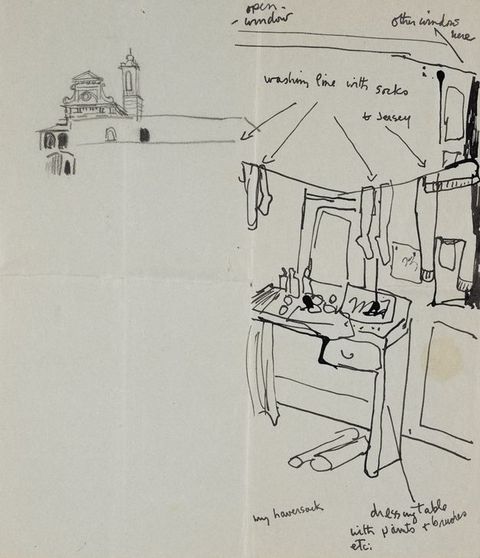

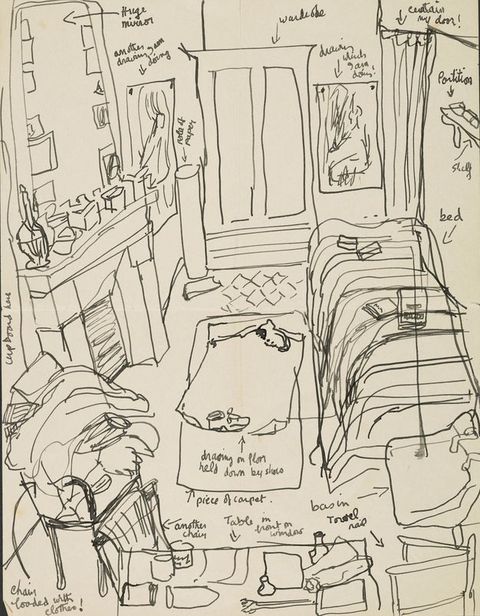
Townhead
In 1953 Eardley moved her supplies to her first independent space, a former photographer’s studio on St. James Road in Townhead, which she maintained until her death. The streets and buildings she navigated were a billowing congestion of industry and family life: laborers, craftspeople, children, cars, clamor, and pollution. Townhead’s sandstone tenements were mired in a century of soot and often clouded by grey-green smog. Eardley commented of the light quality, “Glasgow feels as if it has a sort of lid on top of it”.18 Smoke abatement measures from the Clean Air Act took appreciable effect only after 1959.19 The area was also effectively a construction site. Some buildings were already crumbling while zealous city planners marked the rest for bulldozing. Shortly after Eardley died, her vibrant community was replaced by a roaring asphalt motorway and concrete tower blocks.20
18Eardley’s top-floor studio was wedge-shaped, with flaking walls and paint-splattered floors (fig. 7). It had no electricity, but she maximized daylight from the ample glass ceilings. She sketched outdoors on the street and finished paintings indoors.21 Photos and video footage show numerous sketches hanging from beams or leaning against walls; various paint-covered stools and tables held unmarked jars, bottles, and cans filled with brushes. Her neighbors’ children played and posed in the studio, the floor around them strewn with rags, bottles, and open pots (figs. 8–10). This was no space for controlled portrait sitting. The studio was above a scrap-metal shop, overlooking a busy road corner teeming with local children, street debris, wall graffiti, and exhaust fumes—all of which eventually swept themselves upstairs.
21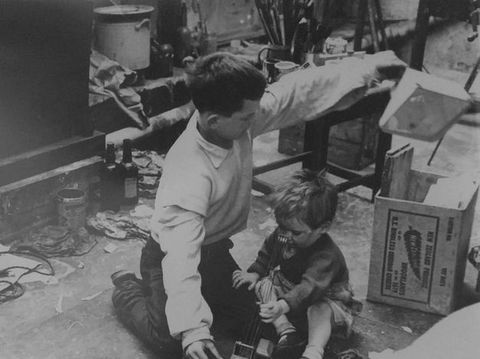
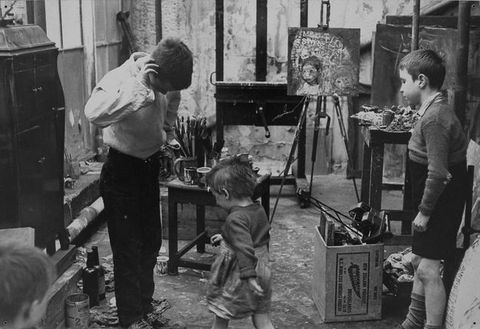
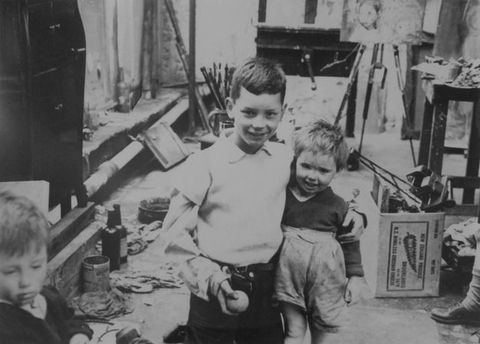
Glasgow Close suggests as much (see fig. 1). It depicts a sandstone tenement in a nearly collapsing, curling perspective. Its tall doorway and window are hinged open like crossed eyes. The warm- and cool-grey masonry is interrupted by three small, vibrant figures: a tumble of cornflower blue and blonde leans out of the window facing down toward a figure who stands against the doorway in a brick-red dress. Viewed under a stereomicroscope, the painting shows tiny particles of environmental debris frozen in brushstrokes, stucco-like, across its surface (figs. 11–14). Their wonky geometry mimics fractals of the tenement’s chunky stone facade. “Grit” is sometimes cited alongside oil paint in written captions of Eardley’s works, although it’s unclear if this microscopic level of debris was intentional or environmental. Perhaps both.
Catterline
An artist friend first brought Eardley to the crescent-shaped harbor of Catterline in 1950 and she returned with increasing frequency for the rest of her life (fig. 15).22 Catterline was a remote, aging fishing village, with a cliffside string of roughly thirty whitewashed homes and about as many residents. At the southernmost end, exposed to fierce winds, was No. 1 The Row, a basic shelter Eardley rented as her studio in 1954. She once wrote, “all the day the wind has been tearing off the sea, getting worse and worse, and tonight poor little No. 1 is getting rocketed about. Every now and then, by an extra hard blast of wind, the door is blown open, and what amounts to a bucket full of rain, sloshed in through the open door”.23 Undeterred by the lack of floors, roof, plumbing, and electricity, Eardley made No. 1 habitable enough until she bought nearby No. 18 in 1959. The latter became home while the former remained a workspace.24
22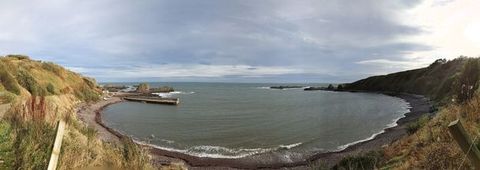
Unlike in Townhead, Eardley painted primarily outdoors in Catterline. She shared this boundaryless workspace with neighbors, farmers, or fisherfolk, whom she knew well, but her work responded more to the wild sky, sea, and fields as she immersed herself and her easel:
25The North East,—it’s just vast waste and vast seas, vast areas of cliff—you’ve just got to paint it. I very often find I will take my paints to a certain place which has moved me and I’ll begin to paint there and I find by perhaps the end of the summer I haven’t moved from that place. My paints are still there. I’ve worn a kind of mark in the ground—no grass left!—and I just leave my paints there overnight and eventually it seems to have built up this other table and generally a studio seems to have arrived outside and that seems to be how I work.25
Photographs show Eardley with large paintings propped low on folding easels. Grass or tide’s edge grazed (or barely avoided) the paint surface—she would have had to crouch to paint lower passages. Inland, she perched her wooden tray palette above a knee-high wood crate, a few open cans or jars rest on top as she held a palette knife, oily rag, and a wide house-painting brush (fig. 16). She tied a stone to the back of her easel for counterweight. In one photo by the sea, she holds a long palette knife and balances a tray over a tripod at hip height. Various-sized cans sit close to her feet, with what appear to be small tubes of paint and groups of long-handled brushes strewn across the muddy ground on either side of her; the sea spray looks palpable (fig. 17).
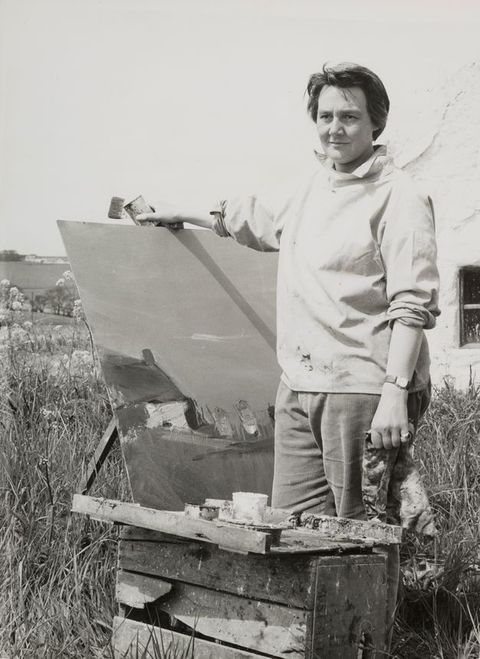

She painted like this all day, year-round. Numerous letters detail her battles with the elements, as she ran in and out with her supplies between blizzards or attached an anchor to her easel and left it “half buried in the snow”.26 She wrote to Audrey Walker about waiting for the tide to turn and setting up on the shore: “before I had got my painting on easel a huge wave came and washed right over my feet and up to my calves. This is only to tell you how strong my boots are—not to frighten you”.27 Heavy rain seemed to be the only thing that drove her practice indoors.28
26Winter Sea III is a frenetic view of the harbor, its dock jutting defiantly from dark rocks into roiling grey, white, and steely blue waves (see fig. 2). Eardley’s viewpoint was looking down from atop the grassy cliffside. In the upper center of the painting, stereomicroscopy reveals an intact beetle, 2.5 mm long, partially submerged in a grey-blue brushstroke (fig. 18). It landed while she painted, its wings enveloped by viscous wet paint. Identified as a rove beetle of the Omalium species, this insect lives in areas with decaying plant matter, including coastal shorelines, where they can be found among seaweed, driftwood, or decomposing vegetation.29
29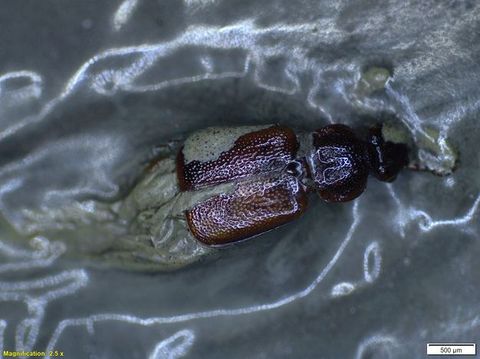
The lower right surface of the painting contains an accumulation of scattered tiny particles in various shades of brown and beige (fig. 19). Eardley was known to embed sand in her paint mixtures; however, under microscopic analysis, none of these particles resemble mineral quartz, mica, or other beach sand material. One, removed from the painting’s far edge as a sample for detailed study, appears organic rather than mineral: its wood-like striations suggest a carbon-based structure (fig. 20).30 The particles that found their way onto her paintings while she painted might be windblown ash or seaweed detritus. Eardley once described working on the cliffside: “Greyness and blowing swirling mists—and latterly a strong wind blowing from the south blowing up great froths of whiteness off the sea, like soapsuds onto the field behind our wee house”.31
30
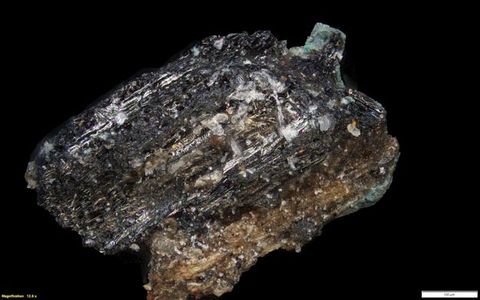
On the back of Glasgow Close is an unfinished landscape entirely unlike Winter Sea III: a grey-brown cottage and white wall frame a rigid ocean view between them (fig. 21). It is unmistakably Catterline, possibly dated around 1952–54.32 The paint is anemic. Diluted and smeared in parts, it was applied in a color-blocked style indicative of her more measured indoor practice. Two drawings at the Aberdeen Art Gallery and Museums Collection depict the same composition with annotated reference notes in Eardley’s hand (“indigo sky”, “raw umber”, “move wall a little”).33 These mnemonic sketches were common for Eardley, but the canvas itself remains an unusual material link between her city and seaside environments. Did she use her notes to paint remotely from Glasgow? How often did she shuttle supplies and sketches between studios?
32
Supplies
Eardley’s letters rarely name specific materials or suppliers, so between her urban and rural access points—each with its own local economy—her potential materials are exponentially vast. The artists’ supplier she most likely frequented in Glasgow was Miller’s Drawing Materials, a favorite haunt for art students.34 From Glasgow to Catterline, a roughly 270-kilometer journey, Eardley travelled by train to Aberdeen, then transferred to the town of Stonehaven, where she was retrieved by car or rode her own scooter the remaining 9 kilometers to the coast. Once there, basic provisions were over a kilometer away, though neighbors often pooled or traded goods among themselves. Her letters mention the occasional “good wee expedition to Aberdeen” to buy paints and sailcloth at an undisclosed shop.35 These might just as easily have been materials for artwork as for studio repair work. Aberdeen was a major urban center, but Eardley’s movements there are not well documented. In general, she was not rooted to artists’ suppliers alone, nor to any single source. Following her commute back and forth, the physical components of her paintings begin to trace a network of anonymous community suppliers across Glasgow, Aberdeen, Stonehaven, and Catterline. These, in turn, were linked to larger postwar global economies in flux.
34Throughout Eardley’s professional career, material change was unavoidable, underpinned by expanding chemical industries and shifting supply chains. Substrates that had hardly changed for centuries—canvases spun from plant fibers such as linen and hemp, or panels planed from hardwood—became more expensive and were harder to find compared to cotton and synthetic fabrics or to construction boards made from processed wood pulp.36 Meanwhile, the physical and chemical properties of paints themselves became seemingly unlimited, driven largely by innovations in solvents and binding media (or binders—the viscous oils or resins that bond to colored pigment particles and create a paint film). Natural tree resins, like dammar, and plant-derived oils, like linseed and poppy, were the long-dominant binders for paints and coatings made for artists and tradespeople alike. By midcentury, industrial paints broke stride: improved synthetic binders such as alkyds, acrylics, and polyvinyl acetates allowed greater durability, mass production, and standardization. Ambitious manufacturers like Imperial Chemical Industries (ICI) in the United Kingdom, or the Rohm and Haas Company and DuPont in the United States, developed these new resins on an unprecedented global scale. At ICI alone, the number of technicians researching paints and plastics grew from 25 in 1938 to 123 in 1952.37
36And, yet, traditional media were not entirely displaced, least of all during this period of transition. Artists still used oils even as they embraced new commercial-grade paints, multiplying the textures, sheen, viscosity, and movement that could be manipulated from each color. Eardley was attuned to contemporary practices, and some conservation records of her paintings propose that gloss house paint was used alongside traditional oils, but the extent to which she mixed media is unknown.
Eardley’s drawing practice is a useful lens for understanding how she utilized materials. An incessant draughtswoman, she often layered multiple media such as gouache, pastel, chalk, and watercolor, and used whatever paper was nearby. She drew on invoice papers and sandpaper, sometimes drafting across different sheets patched together as the sketch outgrew its original dimensions. Perhaps as a consequence of her artistic training during wartime rationing and inflation, Eardley remained resourceful and frugal with materials throughout her career, despite her growing income from gallery sales (interestingly, at her death, she owned stock in ICI).38 Her relentless, immersive routine suggests a keen sensitivity to exploration, control, and serendipity.
38Eardley’s decision-making and options can be staggering to consider. The findings and reflections presented here aim to narrow, rather than define, an understanding of her painting materials, focusing on substrates (canvas and board), ground layers, and two often cited characteristics of Eardley’s palette, particularly in Catterline: her use of boat paint and of hand-ground pigments.39
39Canvas and board
Eardley required a large supply of substrates. She worked on multiple pieces at any given time, griping about “blasted great boards sticking out everywhere” in her Catterline cottage.40 In one letter she describes painting all day, then moving spots at around six o’clock “to paint the evening sky … I bashed away painting sunsets until about 8 o’clock, did three”.41 A bout like this likely produced Stacks at Evening (see fig. 3). Measuring 11 × 16 cm, the tiny board is a manageable scale for fast multiples. A nearly identical piece, Autumn Sky, Catterline, in the Gracefield Arts Centre collection (Dumfries and Galloway Council), is cut to a wider format, suggesting compositional tests (fig. 22).42
40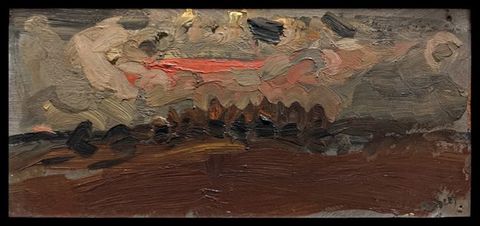
It is not uncommon for her finished paintings, primarily canvases, to hide an abandoned effort on the reverse side. Cordelia Oliver, a fellow art student and later biographer of Eardley, wrote of an early painting that was “no doubt under some later painting, for those were difficult times with new canvas often unobtainable”.43 High-quality linen was especially dear. In the United Kingdom, the artists’ supplier Winsor & Newton wrested a “special allocation of flax yarns” during the war to make a limited supply of linen canvases; production levels never rebounded afterward.44
43The canvas for Glasgow Close is a plain weave of either linen or hemp fibers.45 It has been reused, re-stretched and resized. First, the Catterline scene (see fig. 21) was flipped and stretched to provide a clean surface for the Glasgow composition. This too underwent a size alteration, which is revealed when examined outside of its frame: the left side of the composition continues—fully painted—past the front edge of the picture plane, wrapping around the stretcher bar. Holes from former tacking marks are visible along the bottom stretcher (figs. 23 and 24). Because the paint only extends past the left edge, the original composition must have started at a wider format, possibly horizontal or square, before being cropped to its present vertical at some point in the painting’s lifetime.
45In Catterline, Eardley opted for boards more often than canvas.46 Winter Sea III and Stacks at Evening are painted on 3 mm thick hardboard (also called wallboard), made primarily for industrial use in building and construction projects. Hardboard was a marvel of twentieth-century chemistry and engineering: sawmill waste that was previously discarded or burned was instead ground or pulped, and the natural lignin in lumber was converted into a bonding material for densely packed wood pulp. This created strong, affordable boards that became ubiquitous during the postwar building boom.47 In a letter to Audrey Walker, Eardley requested hardboard from “your joiner—or any joiner”; she also sourced them from a joiner in Stonehaven.48
46On the back of Winter Sea III, a black stamp reads “Royal Board” with a triangular logo and “Made in Sweden” below (figs. 25 and 26). Royal Board was a product of ASSI (Aktiebolaget Statens Skogsindustrier), a Swedish state-owned lumber products group. From 1942 until around 1999, ASSI operated various sawmills, paper mills, and wallboard factories across Sweden, exporting heavily to the United Kingdom throughout the 1950s and 1960s.49 The boards used here are known as “smooth on one side”; a flat metal plate applied even heat and pressure to one side of the wet pulp, while the other side was pressed by a fine wire mesh, leaving a grid imprint. They were sold in large sheets that Eardley cut down as needed (fig. 27).50
49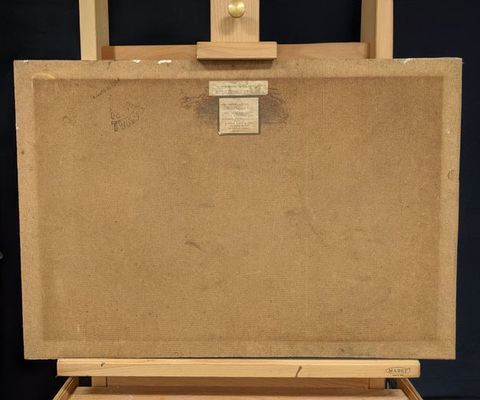
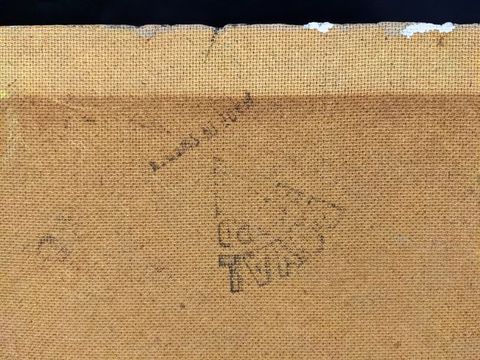
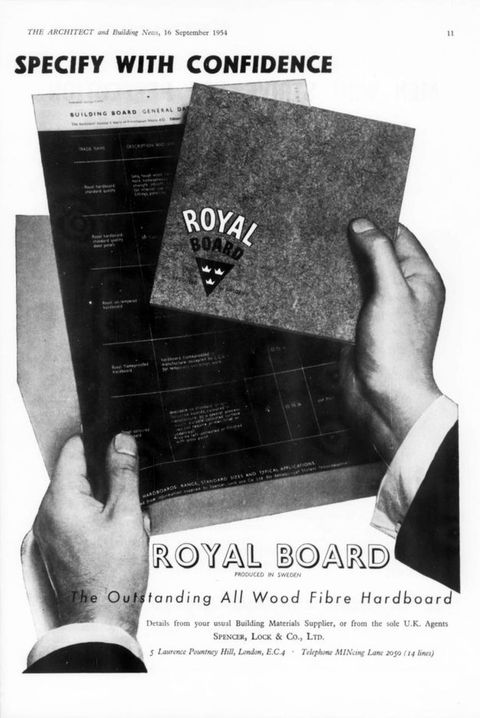
These boards are central characters in many of Eardley’s Catterline letters. Their tensile strength was critical in helping her battle punishing weather. Walker recalled watching her develop a painting for hours when suddenly “I saw the gale lift this great board right up, and fling it, face down of course, on the shingle. It had to be scraped and begun again”, or of another: “you can see the clamp marks where the gale has torn the board away, and all the corners bashed as Joan and I dragged and hauled it down then back up the ice-bound cliff in a real snorter of a gale”.51
51In general, Eardley’s boards speak to simple functionality over careful craftsmanship. The edges of Stacks at Evening and Autumn Sky, Catterline were left jagged and roughly cut.53 Conservation reports for large works similar to Winter Sea III describe rough wooden supports found on the back of the boards, nailed into place from the front through the actual paint surface.54 One early report details the removal of these nails and supports, adding: “painted on a completely unsuitable and ill-fashioned piece of sub-standard hardboard”.55 While these industrial materials are clearly not of archival quality nor stable from a conservation perspective, it is worth considering what is lost from Eardley’s signature practice when these are quietly removed and replaced.
53Ground layers
Eardley mentioned priming her own boards and canvases in batches with what she called “flat white”.56 Conservation documents note the dry, gouache-like appearance of her white grounds, and Cordelia Oliver laments Eardley’s use, in the 1960s, of “a raised ground which has proved to be brittle”.57 It seems safe to venture that Eardley’s grounds were sites of experimentation.
56A painting’s ground (also known as gesso or primer) is a preparatory base applied directly to the raw substrate, making it firmer and less absorbent.58 By design, grounds are usually unseen, yet they affect the appearance and application of all subsequent paint layers. In Eardley’s time, painters could purchase prepared grounds or create bespoke mixtures to maximize haptic, optic, and textural preferences. Throughout the 1950s, lead white—arguably the most common ground pigment for centuries—was steadily overtaken by the more chemically stable and nontoxic titanium white. This was paired with new acrylic resin binding media, rather than oils, marking a monumental transition for artists.59 One conservator recently estimated that at least 90 percent of the post-1965 paintings she has examined had used an acrylic ground.60 But because artists’ acrylics were largely unavailable in Britain until around 1963, it is unlikely that Eardley ever used them.61
58Pigment analysis of the three works in this study revealed titanium white in many paint layers but not in the grounds.62 It is possible Eardley used different “flat whites” in each studio.63 The thick, matte ground in Glasgow Close, accumulated in brittle globs on the painting’s edges, is composed primarily of calcium carbonate (chalk) with zinc oxide (figs. 28–32). The two Catterline paintings have razor-thin grounds that indicate barium sulfate (barite or blanc fixe) with zinc oxide, or lithopone white (figs. 33–38). Pigment particles from the grounds in Stacks at Evening and Glasgow Close are also visually distinct, with those from the former composed of more heterogeneous shapes and sizes. Binders could not be determined in the tested samples, as spectral analysis was obscured by the overwhelming presence of carbonates and sulfates.64
62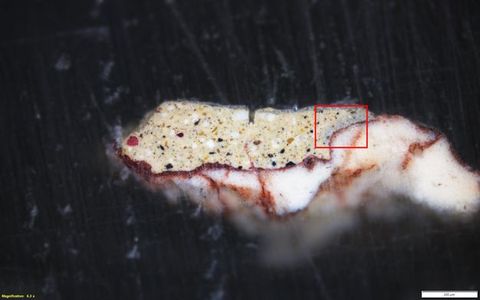
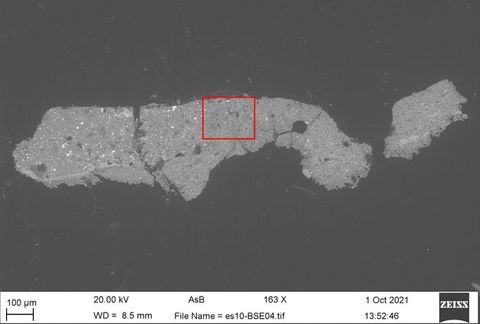
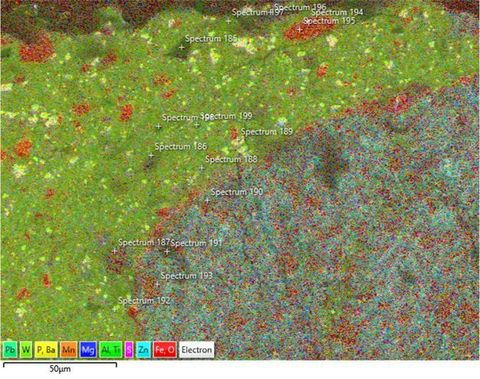
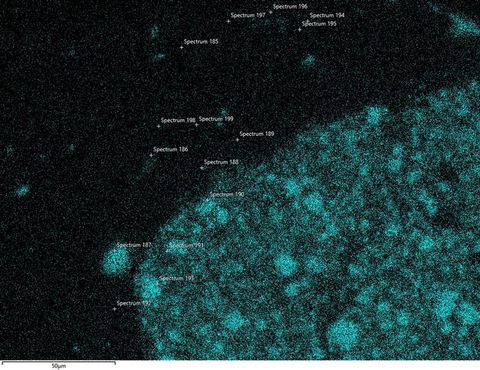
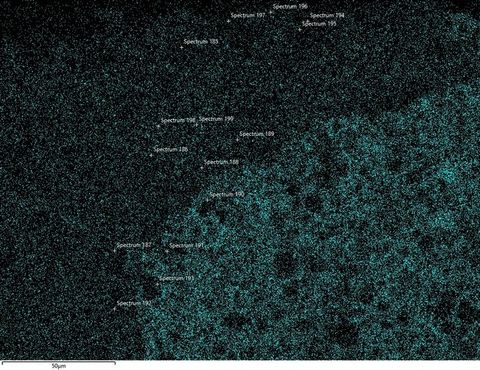
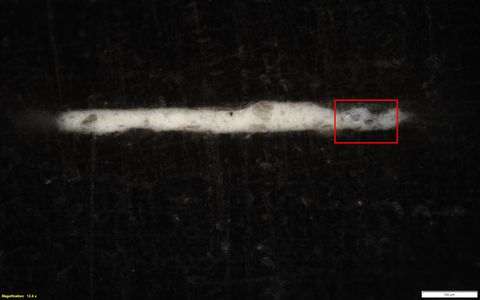

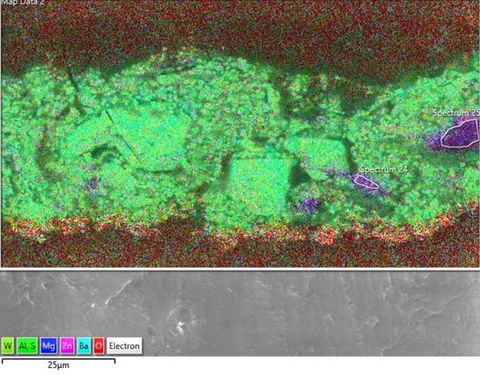
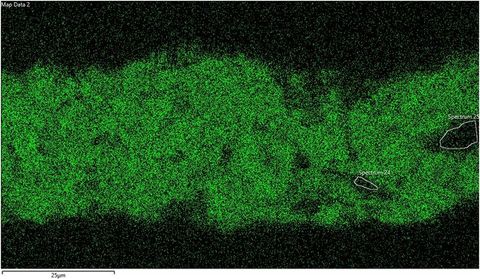
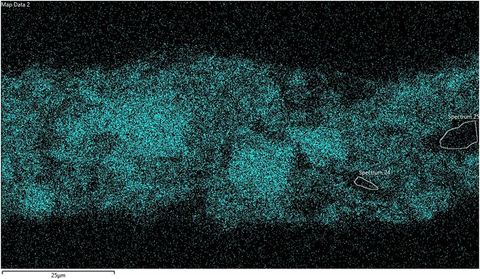

Chalk and, to a lesser extent, barite or lithopone were common components of artists’ grounds, but they were also widely used in commercial paints.65 One popular chalk-based interior house paint of the time, distemper, was sold as a liquid or as a dry powder to be mixed with warm water and glue.66 Photos of Eardley’s Townhead studio show boxes of distemper powder on a shelf alongside various bottles and jars (figs. 39 and 40). The brand Coronette was distributed by Crown Colour Works, located just down the road from her studio. While this is not evidence that her chalk ground was distemper, it does merit attention, recalling that Eardley painted the walls of her first Townhead workspace with blue distemper, then used it as “a sort of luminous ground” in several drawings.67 For artists, distemper was closely associated with tempera paint and valued for its color brilliance and rapid drying time; however, it was generally used on panels or other rigid supports. Its use as a canvas ground is less documented.68
65

Boat paint
Boat paint is sometimes listed as part of Eardley’s experimental mixed media in Catterline.69 She would have certainly had access to these paints there, as well as in Glasgow, Aberdeen, and Stonehaven—all places tied to maritime industries. And she presumably used them during her wartime work in a boatyard. But what exactly was “boat paint” as she knew it? The coatings used in small postwar fishing economies like Catterline’s are largely understudied.70
69Marine coatings varied widely depending on the type of vessel, its function, geography, and the preferences (even superstitions) of its owner. On any one vessel, different coatings were used on the wheelhouse and the outer hull, below and above the waterline. Below, antifouling or “bottom paint” often contained biocides such as red lead, copper, or mercury to prevent corrosion and organic growth underwater; above that, various combinations of durable gloss paint and varnish were used.71
71Boatyard workers repainted fishing vessels annually, at the end of one season in preparation for the next. In Catterline, this likely centered around the crab or cod seasons.72 Competitive edge was critical: improved varnishes or resins protected the resilience of a vessel and its owner’s livelihood. Manufacturers issued promotional brochures with glossy samples, but actual recipes remained trade secrets. One manufacturer, Craig & Rose, based in Edinburgh, was known locally for durable paints—as used on the Forth Bridge—and countless varnish mixes for surfaces such as hulls, floors, and pews (fig. 41).73 The industry behemoth, International Paint Company, specialized in marine coatings, which were manufactured in over twenty worldwide factories by 1953, including one in Glasgow. Their advertisements touted the benefits of their paints: increased fuel efficiency, faster vessel speeds, and lower annual painting costs (fig. 42).74 Each season, supply shops or chandleries selected their stock according to the needs of local fisherfolk, who may have welcomed or mistrusted new technologies and were often motivated by family or community traditions, especially for aesthetics. Scottish fisheries on the east coast preferred a less glossy or varnished look compared to their rivals in the west, and newfangled hull colors like bright blue or green gained only selective acceptance beginning in the late 1950s.75 Several of Eardley’s paintings after 1960 depict Catterline’s few boats on the shore: at least one was blue and one green.
72At the time, industrial paint manufacture—of which marine coatings were a highly specialized subset—was transitioning from a craft-based process to a more scientific one, alongside developments in synthetic polymer resins. Compared to natural oils and resins, synthetics proved to be ideal standardizable binding media for high-intensity paints.76 With local paint supplies moving quickly each season, and manufacturers vying for consumers’ trust, it seems improbable that even small markets like Catterline could opt out of these globally shifting technologies.
76To establish a base point, the Scottish Fisheries Museum in Anstruther allowed me to take paint samples from two historic boats in their collection that likely retain midcentury paint: Lively Hope, with a blue underlayer (later painted over in green), and Gleanaway, with a tan-brown wheelhouse that has never been repainted. Focusing on binding media, all tested samples indicate a synthetic alkyd-based resin, with plasticizers included in the Gleanaway samples (figs. 43–45).77 Alkyds are durable, oil-modified polyester resins that were developed at the turn of the twentieth century and refined over decades; they gained wide popularity after World War II, particularly in gloss house paint. Several midcentury artists are known to have painted with alkyds.78 In tested samples of blue, brown, and white paints from Eardley’s works, however, alkyds could not be clearly identified (figs. 46–48). Oils and natural resin binders, such as copal or dammar, can be tentatively attributed, but the diverse mixed pigments and media in each sample obscured definitive spectral analysis.79
77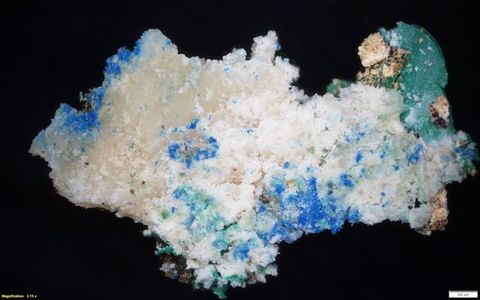
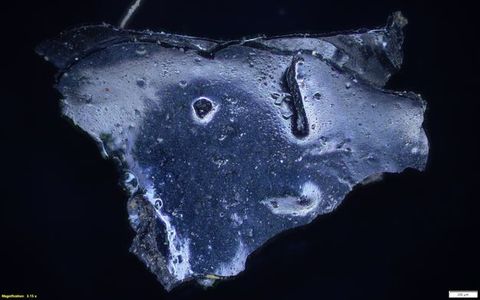
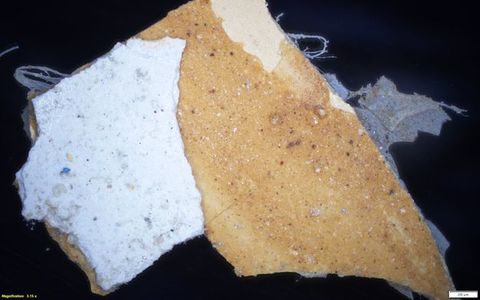
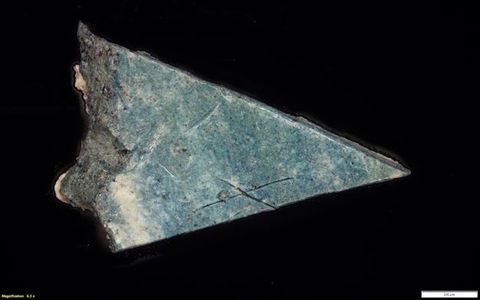
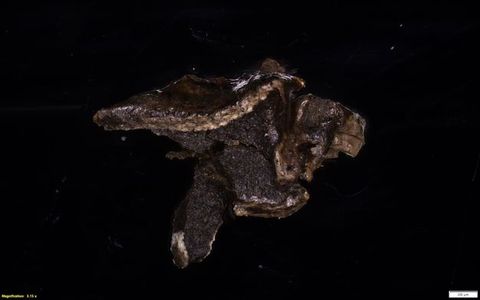
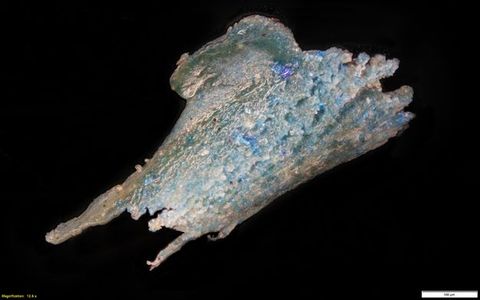
This provides groundwork for deeper study. Eardley’s niece, Anne Morrison, suggests that, rather than mixing marine paint into her general palette, Eardley was more targeted: the blue and green boats in her later works (unavailable for this study) might have been painted with the boats’ actual coating.80
80Hand-ground pigments
Catterline photographs by Audrey Walker show Eardley leaning into a glass muller to spread a dark, chunky substance over a countertop (figs. 49 and 50).81 She appears to be grinding pigments—a traditional process, considering that prepared paint was widely available and easier to replenish on her fast-moving palette. Walker’s photos are a key record, as Eardley’s archived letters do not discuss this aspect of her practice.
81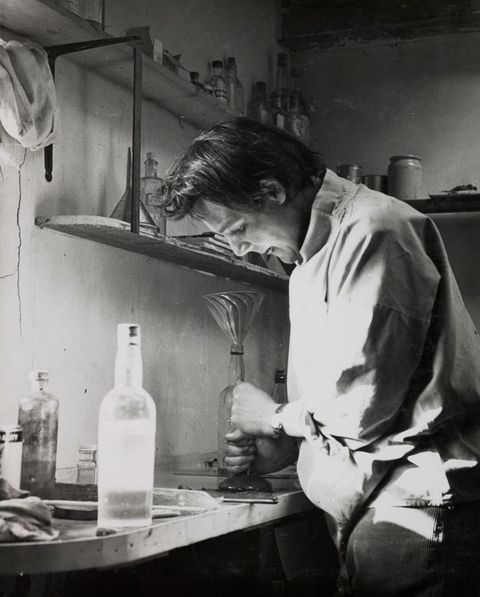

Physical evidence in the paintings themselves is difficult to parse. Pigment particle size and uniformity can help distinguish between hand- and mechanically ground paints: by the 1950s, motor-powered roller mills produced finer, more homogeneous particles compared to hand-ground ones, which are larger and heterogeneous.82 In six Eardley paint samples, cut to cross-sectional view to reveal paint stratigraphy, each color layer appears relatively homogeneous. Most particles measure 5 microns (0.005 mm) or less. The ground in Stacks at Evening is an outlier, containing irregular grains measuring up to 50 microns each (0.05 mm) (see figs. 33 and 34).83 However, mixing and grinding paint is a labyrinthine process with numerous variables—there is no standard particle size for all colors. Whether ground by hand or by machine, this metric differs from pigment to pigment, and from manufacturer to manufacturer.84 The paintings in this study include many standard pigments in various states of admixture. A preliminary list includes cadmium reds and yellows; vermilion (mercury sulfide) red; iron-oxide ochres; arsenic and chrome greens; cerulean (cobalt stannate) and Prussian blues; carbon black; and various whites including barite, titanium, zinc, and lead whites. Determining if any of these colors were hand-ground requires analysis outside the scope of this article.85
82Nonetheless, the photographs provoke useful questions and considerations. Nearly every Joan Eardley biography uses these images. One affirms her “bright colours were ground and mixed in the cottage and once out of doors they were applied quickly with a palette knife, house painter’s brushes … smaller brushes and rags”.86 A 1963 news article about Eardley stated that she “spends much of her time making her own paints” during winter, when there is less sunlight for outdoor painting.87 Yet one of the archived photos is physically annotated “Catterline—Summer 1961”.88 Was it a seasonal task or more routine? Making paint by hand is incredibly slow labor, yielding small quantities. This seems impractical for Eardley’s large boards and her penchant for documenting unpredictable weather (with unpredictable colors). In the photos, the amount of paint she prepares is slight.
86Recent scholarship has proposed that Eardley was making “runny” paint to drip and splash, connecting hand-ground pigments to increased liquidity.89 However, prepared paints are commonly adjusted with liquid dilutants such as turpentine to achieve a looser consistency, and the method of hand-grinding specifically does not benefit from floods of oil. Rather, controlled amounts are slowly added to the dry pigment powder as the mixture is evenly pressed and smeared into a smooth paste with soft peaks. One ubiquitous painting manual of the time, The Materials of the Artist by Max Doerner, warns that hand-ground paints should “not run like house painters’ paint”; he explicitly encouraged this method because factory-made artists’ paints were too oily and lacked body, having gone “through the rollers much too often”.90
89Midcentury British painters kept their finger on the pulse of developments in paint manufacture. They read news of their US counterparts who tested and advised on early iterations of artists’ acrylics.91 But, while this era tends to be framed in terms of its novel formulations, painters were hungry to manipulate mixtures of all kinds—new, old, viscous, liquid. Surface experimentation itself was the draw.92 Hand-grinding paint might have been old-fashioned, but it was also entirely contemporary.
91At the time, a growing number of mass-produced publications enabled painters to harness the technical aspects of their craft. Material-focused columns in art journals and magazines, or popular books such as Doerner’s, took a scientific, instructional approach to historical recipes and contemporary practices alike. Many authors were themselves artists.93 Others, like Rutherford Gettens and George Stout, worked in the field of conservation–restoration, which was becoming a data-driven laboratory science, propelled by material analysis instruments honed for industrial and military research. Their 1942 manual, Painting Materials: A Short Encyclopaedia, detailed the physical and chemical properties of pigments, binders, and other media. In the preface to the 1966 revised edition, the authors expressed surprise and gratitude that so many painters (as opposed to museum professionals) had embraced the book.94
93Eardley was an avid reader with a robust studio library that was not systematically catalogued after her death. Of the books kept by her family, none are technical manuals. Those that remain indicate a broad range of painterly interests, from historic mural (tempera) techniques to a 1957 copy of New Art in America, which discussed twentieth-century painters in essays laden with materiality.95 She also greatly admired Vincent Van Gogh and likely studied his methods: a major English-language translation of his letters, published in 1958, revealed his own attention to coarsely ground pigments.96
95By hand-grinding paint, Eardley might have sought to control optical characteristics such as opacity or luminosity. The granular structure of each pigment can impact color brilliance: smaller, machine-ground particles reflect or scatter more light, causing some colors to appear less saturated.97 Powdered pigments were more cost-effective than tubes or tins, so perhaps she stretched resources for premium colors this way, saving them for selective passages or specific hues. But the assumption that she was making oil paint in the photographs also overlooks other possibilities. Tempera or pastels could both be made by hand from pigment powder. Pastels, in particular, were a staple in Eardley’s robust drawing practice, and some midcentury artists did use them in paintings.98
97The exact material she concocts in Audrey Walker’s photographs is enigmatic, but the labor itself is revealing. Painting is, above all, a process of haptic research. Properties such as texture, hue intensity, and drying time—all determined by the complex chemistry between pigments, binders, and other additives—are the very nexus of a painter’s language. Eardley’s letters overflow with technicolor descriptions of how she saw the world, and she was nothing if not obsessed with her daily craft. That these photos were taken only in one studio late in her career should not limit their potential interpretations. Eardley probably tinkered with many variations of paint, not only in Catterline but also in Glasgow.
Gesture and Application
Eardley’s mark-making and paint texture took many forms. In Townhead and Catterline, photos show an arsenal of brushes in all sizes and bristle shapes and various palette knives close at hand to help her think through and load colors rapidly. In a video filmed at her Townhead studio in the early 1960s, she paints with quick and decisive strokes, gripping brushes or knives in a tight fist (fig. 51). Layers of paint from previous sessions had been left to dry and harden before she added new passages and scraped down into others, as if excavating the surface.99 None of the three works in this study were painted on top of a preparatory charcoal underdrawing; instead, Eardley drew with paint.100 She accomplished this in different ways. Variations in the weight, speed, and layering of her line work are distinct in each painting.
99In Glasgow Close, Eardley’s media is heavy. Above the white ground is a thin red wash, likely a base tone, but this is smothered by four or five thick paint layers. Bits of unidentified particles are suspended in brushstrokes, adding a plaster-like texture to the generally matte surface. Areas of intentional scumbling and scraping, and less intentional cracking paint from the dense impasto, reveal several subsurface color layers. This is most readily seen in the doorway, the window, and the three figures. Eardley would have left this painting to dry at various stages to accomplish the effect of thick buildup and lateral scraping down, as in the video. She left no breathing room for thin washes or visible canvas weave (figs. 52–55).
By contrast, the two Catterline works display more of a sweeping gestural stride, with wet-on-wet painting and selective impasto. They are not scumbled and scraped. Both Stacks at Evening and Winter Sea III are built up as a crescendo from the edges to the center of each painting. The outer margins of the compositions are a semitransparent grey-brown wash that barely conceals the ripples of wide brushstrokes below it, made from the application of white grounds. From there, the paint is worked to a thick impasto toward the center. The level of sheen varies from color to color, with some of the dark grey, black, or turquoise hues appearing glossier than others.101 In Stacks at Evening, only a few decisive brushstrokes establish the pink-yellow dusk Eardley had observed (figs. 56–58).
101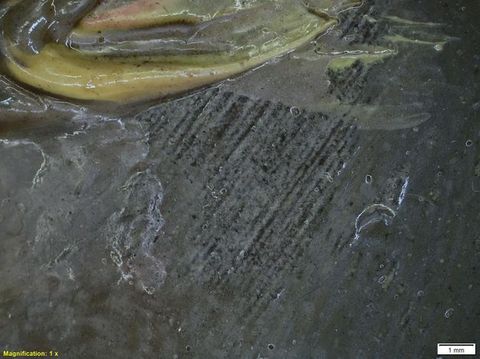
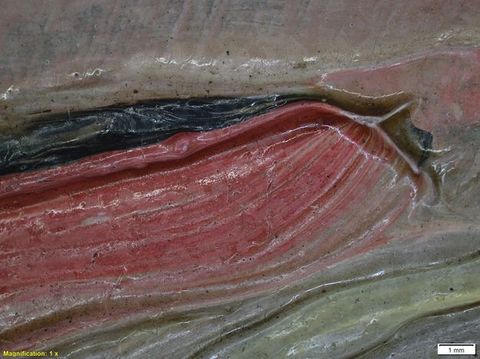

More complex gobs of paint churn across Winter Sea III, with some passages appearing marbled from brushes loaded with multiple colors at once (figs. 59–61). Eardley is reported to have used crumpled newspaper for raised effects, which may explain one particularly sculptural knot of glossy, black-brown paint near the center of Winter Sea III (fig. 62).102
102Given these distinct approaches, time seems to be a critical factor in how Eardley selected and applied materials. Oil paints are slow-drying media, so working on multiple paintings simultaneously helped maintain momentum. In Townhead, on her solid easel indoors, she allowed surfaces to dry and harden for later reworking. On the coast, with her folding easel, she worried more about shifting seasons, weather patterns, tides, and the limits of her own body: “Yesterday I was near dead at the end of the day, working at top speed—today I will take it easier as I realize it will continue”.103 As part of my research, I visited Catterline to sketch in blustery autumn and found my hand stiffening from the cold after drawing outdoors for a mere half hour. My line work became fast and rigid.104 Eardley’s tenacity was obviously more well honed, but so was her haptic knowledge—her command of speed, temperature, and dexterity. In Catterline, she seemed to use brushes and paint as if they were drawing materials, like pastels, with a faster hand–eye connection and no time to wait. Light quality is closely related: Eardley did not have electric lighting in either studio, so she worked in the daytime. Slow, rolling shifts in the intensity and color of light in smog-afflicted Townhead, or the volatile seasonal clouds of Catterline, influenced her color choices. Summer in Catterline was perhaps the exception, when daylight lingered. Working on a series of cornfields, she observed: “my palette has changed almost imperceptibly from greens to yellows to orange. So I reckon the ripening process has shifted more than I am really aware of”.105
103The present study does not include Eardley’s summer paintings, but comparing her work from both studios by season may elicit connections or patterns of surface quality and drying time. Seasonal markers have served as reference points for dating and naming her work, for example Winter Sea III, but they could also define her paint handling. And, while the nuances of light as she experienced them are impossible to recreate, it is important to bear this in mind when we view her paintings today in a gallery or conservation lab, under uniform and neutral lighting in seasonless spaces.106
106Formats of Memory
When I began this research, I sought proof of Joan Eardley as a catalyst for technical innovation, a painter who used nontraditional materials such as boat paint or beach sand in new and novel ways. This is a common framework of art history, a metric of value that distinguishes individual artists from their peers. Instead, I found evidence of someone who blurred traditional and contemporary technologies and who was inextricable from her peers—not only artists but also joiners, builders, fisherfolk, family, neighbors, and their children. The Eardley who emerges in this study is one who fluctuates. She moved frequently between her urban and rural studios—each structure was at once indoors and outdoors, humid and dry in turns. She painted with both old techniques and ones she developed on the fly. She sometimes used supplies with great care and attention, sometimes not. Her paintings are a textured tangle of foraged and intentional gestures; her studios were sites of trial and error, give and take, patience and speed. All this fed Eardley’s cyclical process.
Dredging the untidiness of painting, experimentation, and material change at midcentury, this study has begun to record a more subtle understanding of Eardley’s workspaces and the tools and technologies that shaped her visual language. While most exhibitions, articles, and reviews have divided Eardley’s Glasgow and Catterline, here her places are both distinct and reciprocal: she developed communities and practices unique to each location, yet her supplies also traveled between them, blurring their boundaries.107 The lesser-studied hubs of Aberdeen and Stonehaven exercised a quiet connective sway that merits further study. And many more questions remain. Just as these three works cannot be seen as representing her entire prolific output, the scientific analysis used here reveals only a microscopic fraction of each dynamic painted surface (figs. 63–65). The complexities and unknowns of Eardley’s practice demand richer comparative data. Understanding her potentially unstable ground layers and mixed binding media will impact the ongoing stewardship and preservation of her work, while acknowledging that she reused supports and weather-embattled boards adds historical and environmental context to her practice. Each vignette above proposes avenues for further research.
107
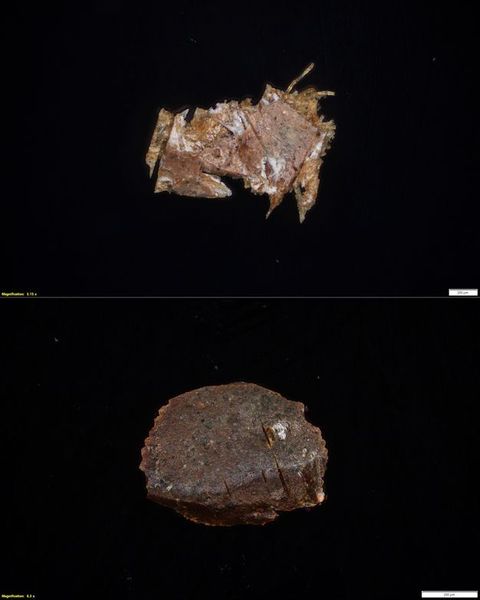
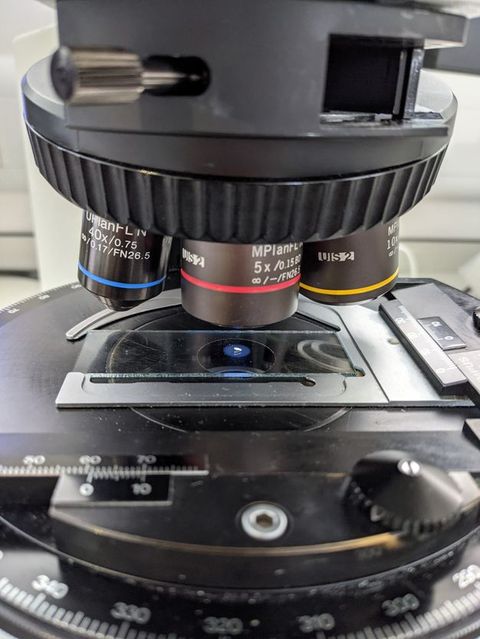
Beyond simply recording, this study is also a form of preservation. After she died, Eardley’s chaotic, dynamic studios were not meticulously preserved as sites of cultural significance, as were those of some of her peers.108 The Scottish painter John Lowrie Morrison, who studied in Glasgow in the late 1960s, recalled, “I found her studio in Townhead when they were pulling the tenements down. The door wasn’t locked and there were drawings on the floor. I was going to take them away, but I was too honest. When I went back, the building was rubble”.109 Documentation of Eardley’s daily practice is scattered across the letters, photos, and memories that were held by her close cocoon of friends and family—nearly all of them women, many of whom were artists, and some of whom, like Eardley herself, identified as lesbian. Most of their documents and accounts have been archived; some letters were embargoed until the 2010s and some remain private.
108Embedded in Joan Eardley’s paintings are memories of when, where, and how they were crafted (fig. 66). The work of illuminating them—and her—is ongoing.
Acknowledgements
I am grateful to the Johnstone sisters, the Association for Art History, and Andrew Robertson for supporting my travel and on-site work as a 2021 Hunterian affiliate. Thanks to Christina Young and Anne Dulau Beveridge for their supervision. Many colleagues at the Hunterian, Glasgow Museums Resource Centre, National Libraries Scotland, Scottish National Gallery of Modern Art, Maggie Law Museum, and Scottish Fisheries Museum kindly provided guidance and expertise throughout my research; they are named throughout the article. Thanks also to Baillie Card and Maisoon Rehani at British Art Studies. Special acknowledgment is due to Tess Visser, Valentina Risdonne, and Michela Botticelli for their collegiality and generosity, and, far above all, to Alex Myrvold.
About the author
-
Natalie Lawler is a visual artist and curator. Her research and studio practice explore the history of painting technologies and the tension of color as a visual and verbal language. She is currently coauthoring a publication, Worlds Unfolding, centered on the histories of science, technology, and medicine as told through collection materials at the Huntington Library, Art Museum, and Botanical Garden (forthcoming, Princeton University Press). Previously, she was a research affiliate at the Hunterian and the Kelvin Centre for Conservation and Cultural Heritage Research (Glasgow, Scotland); curator of art collections at Chapman University (Orange, California); project intern at the International Centre for the Study of the Preservation and Restoration of Cultural Property (ICCROM; Rome, Italy). She studied technical art history at the University of Glasgow and drawing and painting at California State University, Long Beach.
Footnotes
-
1
Joan Eardley to Audrey Walker, 1955, Acc. 11826, National Library of Scotland Archives and Manuscripts Division Repository, Edinburgh. ↩︎
-
2
Notes by Audrey Walker, circa 1964, Acc. 11826, National Library of Scotland. ↩︎
-
3
For a thorough biography, see William Buchanan, Joan Eardley (Edinburgh: Edinburgh University Press, 1976); and Cordelia Oliver, Joan Eardley, RSA (Edinburgh: Mainstream, 1988). ↩︎
-
4
Scholarship by Harriet Standeven is noteworthy. See, for example, House Paints, 1900–1960: History and Use (Los Angeles: Getty Conservation Institute, 2011); “The Appeal of an Image: The Explosion of Commercial Paint Use amongst Britain’s Abstract Artists in 1956”, Third Text 20, no. 2 (2006): 251–58, DOI:10.1080/09528820600590892. ↩︎
-
5
Mary H. Gridley, “The Structural Treatment of Modern and Contemporary Canvas Paintings: Changing Approaches and Considerations”, in Conserving Canvas, ed. Cynthia Schwarz et al. (Los Angeles: Getty Publications, 2023), 314–15, DOI:10.2307/jj.6142260.42. ↩︎
-
6
Joan Eardley to Audrey Walker, 1958, Acc. 11826, National Library of Scotland. ↩︎
-
7
In many cases, Joan Eardley’s correspondence was dated retrospectively. Christopher Andreae, Joan Eardley (Farnham: Lund Humphries, 2013), front matter. See also Oliver, Joan Eardley, 84. ↩︎
-
8
All testing conducted at the Kelvin Centre for Conservation and Cultural Heritage Research. This study utilized stereomicroscopy; optical microscopy; paint sampling; ultraviolet imaging; infrared reflectography; Fourier transform infrared (FTIR) spectroscopy; portable X-ray fluorescence (XRF); and scanning electron microscopy coupled with energy-dispersive X-ray microanalysis (SEM-EDX). I conducted lab work and imaging under the supervision of Christina Young, professor of conservation and technical art history, University of Glasgow, and Anne Dulau Beveridge, curator at The Hunterian, with assistance from Tess Visser, Michela Botticelli, and Valentina Risdonne. Christina Young extracted the paint samples following best professional practices. I collected samples of contemporary boat paint from vessels at the Scottish Fisheries Museum, Anstruther, in coordination with Linda Fitzpatrick, head curator. The observations and analysis presented here are my own, unless otherwise noted. ↩︎
-
9
Paintings unframed by Andrew Boyle, collections technician, The Hunterian, in coordination with Malcolm Chapman, head of collections management, The Hunterian, and Aileen Nisbet, conservation manager, The Hunterian. I am grateful to all three. ↩︎
-
10
For records of paintings outside the Hunterian collection, many thanks to Suzanne Ross, paintings conservator, and Ed Johnson, assistant curator of collections, at the Glasgow Museums Resource Centre. The present study builds on “Bashed, Dragged, and Hauled: The Materials and Painting Methods of Joan Eardley in Glasgow and Catterline” (an unpublished paper that I presented at the College Art Association Annual Conference, Chicago, 2020). ↩︎
-
11
With gratitude to Kerry Watson, librarian, and Fiona Menzies, archivist, at the Scottish National Gallery of Modern Art; and to the reader services team at the National Library of Scotland. ↩︎
-
12
Joan Eardley explored diverse subject matter beyond portraits and landscapes. See recent scholarship by Susannah Thompson and Jenny Brownrigg, “Early Eardley: A Reconsideration of Joan Eardley (1921–1963)”, British Art Journal 22, no. 3 (2022): 64–79; and Oliver, Joan Eardley. ↩︎
-
13
Joan Eardley to her mother, Irene Morrison, Joan Eardley Archive, GMA/A09/1/1/78-78.2, Scottish National Gallery of Modern Art, Edinburgh. ↩︎
-
14
Joan Eardley to her mother, Irene Morrison. ↩︎
-
15
Laura Bronwen Gordon, quoted in Andreae, Joan Eardley, 90. ↩︎
-
16
Buchanan, Joan Eardley, 23. ↩︎
-
17
Joan Eardley, “I’m Just Trying to Paint”, audio interview, produced by Hart Street Studios, 12 July 1995, cassette tape, 30:00, Joan Eardley Archive, GMA/A09, Scottish National Gallery of Modern Art, Edinburgh. This copy is believed to be an edited version of a BBC interview from 14 January 1963, as cited in Patrick Elliott and Anne Galastro, Joan Eardley: A Sense of Place (Edinburgh: National Galleries of Scotland, 2016), 127. ↩︎
-
18
Buchanan, Joan Eardley, 53. ↩︎
-
19
“Glasgow’s Quinquennial Review”, Official Architecture and Planning 24, no. 2 (1961): 65–66; see also Murdo Morrison, “The ‘Good Old Days’—Growing Up before Clean Air”, Murdo Morrison Website & Blog, 6 March 2017, https://www.murdomorrison.com/single-post/2017/03/06/the-good-old-days-growing-up-before-clean-air. ↩︎
-
20
A. G. Jury, “Townhead (Glasgow) Comprehensive Development Area”, Official Architecture and Planning 25, no. 9 (1962): 535–37. ↩︎
-
21
Prolonged sketching became painful after she suffered a slipped disc in 1956, so she used reference photographs, often taken by Audrey Walker. Many of these photos, held in the Joan Eardley Archive at the Scottish National Gallery of Modern Art, include paint-smeared fingerprints along their edges. ↩︎
-
22
Annette Soper, a schoolteacher and artist in nearby Stonehaven, drove Joan Eardley to Catterline after a gallery show in Aberdeen. Eardley occasionally borrowed the Soper family’s Watch House in Catterline until she secured her studio: Oliver, Joan Eardley, 60–64. For recent in-depth research on Joan Eardley within the history and community of Catterline, see Patrick Elliott, Joan Eardley: Land & Sea—A Life in Catterline (Edinburgh: National Galleries of Scotland, 2021). ↩︎
-
23
Buchanan, Joan Eardley, 72. ↩︎
-
24
Buchanan, Joan Eardley, 55–57; Oliver, Joan Eardley, 76. ↩︎
-
25
Joan Eardley, “I’m Just Trying to Paint”. ↩︎
-
26
Oliver, Joan Eardley, 84. ↩︎
-
27
Joan Eardley to Audrey Walker, undated, Acc. 11826, National Library of Scotland. ↩︎
-
28
Joan Eardley, Letters, circa 1957–58, Acc. 11826, National Library of Scotland. ↩︎
-
29
With much gratitude to Jeanne Robinson, curator of entomology, The Hunterian, and Mike Denton, specialist in staphylinids/rove beetles, for this identification. ↩︎
-
30
Many thanks to John Faithfull, curator of minerology/petrology, The Hunterian, and Neil Clark, curator of palaeontology, The Hunterian, for this observation. The surface particles also appear black under ultraviolet imaging. ↩︎
-
31
Joan Eardley to Audrey Walker, undated, Acc. 11826, National Library of Scotland. ↩︎
-
32
Elliott, Joan Eardley: Land & Sea, 61. ↩︎
-
33
See View between Two Buildings, Catterline, Aberdeen Archives, Gallery & Museums, https://emuseum.aberdeencity.gov.uk/objects/7041/view-between-two-buildings-catterline; and The Sea Seen between Two Buildings at Catterline, Aberdeen Archives, Gallery & Museums, https://emuseum.aberdeencity.gov.uk/objects/7040/the-sea-seen-between-two-buildings-at-catterline. ↩︎
-
34
Later known as Miller’s Art Shop, it is now operated by Greyfriars. The shop did not respond to enquiries for archived supply catalogues (if extant). See David Leask, “Bid to Save Scotland’s Oldest Art Store from Closure”, Business, Herald, 10 October 2013, https://www.heraldscotland.com/business_hq/13126615.bid-save-scotlands-oldest-art-store-closure/. ↩︎
-
35
Joan Eardley to Audrey Walker, 22 February 1958, Acc. 11826, National Library of Scotland. ↩︎
-
36
Christina Young and Alexander W. Katlan, “History of Fabric Supports”, in Conservation of Easel Paintings, ed. Joyce Hill Stoner and Rebecca Anne Rushfield, 2nd ed. (New York: Routledge, 2021), 144–47. ↩︎
-
37
W. J. Reader, Imperial Chemical Industries: A History, vol. 2, The First Quarter Century 1926–1952 (London: Oxford University Press, 1975), 450. ICI was bought by AkzoNobel in 2008 and Rohm and Haas by Dow Chemical Company in 2009, while Dow and DuPont initiated a corporate merger in 2015. See also Harriet Standeven, “The Development of Decorative Gloss Paints in Britain and the United States C. 1910–1960”, Journal of the American Institute for Conservation 45, no. 1 (2006): 51–65; and Stuart Croll, “Overview of Developments in the Paint Industry since 1930”, in Modern Paints Uncovered: Proceedings from the Modern Paints Uncovered Symposium, ed. Tom Learner et al. (Los Angeles: Getty Conservation Institute, 2007), 17–29, http://hdl.handle.net/10020/gci_pubs/paints_uncovered. ↩︎
-
38
Eardley’s financial stability throughout the 1950s is somewhat opaque. She was from a middle-class background, lived a spartan lifestyle, and reportedly lived on stocks and shares throughout her life. See Fiona Pearson and Sara Stevenson, Joan Eardley (Edinburgh: National Galleries of Scotland, 2007); and Elliott, Joan Eardley: Land & Sea, 51. ↩︎
-
39
A complete summary of all examination results is outside the scope of this article, which presents selected relevant findings. ↩︎
-
40
Joan Eardley to Audrey Walker, 10 August 1960, Acc. 11826, National Library of Scotland. ↩︎
-
41
Joan Eardley to Audrey Walker, 8 September 1955, Acc. 11826, National Library of Scotland. ↩︎
-
42
I viewed this work on exhibit in 2021 at Gracefield Arts Centre, and the hardboard edges were visible within its frame; however, it was labeled as oil on canvas. The listed dimensions, 11 × 14.9 cm, may also require review, as it is visibly wider than Stacks at Evening (11 × 16 cm). See Autumn Sky, Catterline, by Joan Eardley, DUMGC:432R, DG Culture, Dumfries & Galloway Council, https://dgc-web.adlibhosting.com/Details/collect/80000161. ↩︎
-
43
Oliver, Joan Eardley, 13. In Catterline, Eardley repurposed paintings as rain canopies inside her studio. ↩︎
-
44
Rosamond D. Harley, “Artists’ Prepared Canvases from Winsor & Newton 1928–1951”, Studies in Conservation 32, no. 2 (1987): 83, DOI:10.2307/1506295. ↩︎
-
45
Hemp and linen fibers display a similar cellulosic structure under polarized light microscopy. Guidance with fiber sample preparation and analysis was kindly provided by Paul Garside, lecturer in conservation science, University of Glasgow. ↩︎
-
46
Elliott and Galastro, Joan Eardley: A Sense of Place, 58. ↩︎
-
47
The term “hardboard” is used here to avoid confusion with similar products. Its method of production is sometimes referred to as the Masonite process, although not all manufacturers used this brand-specific process. See A. Halvar Lundberg, “Hardboard, and Its Manufacture”, Pulp & Paper 22, no. 12 (November 1948): 82–84; see also Rodger M. Dorland, “Action on the American Chemical Front: The Hydrolosis of Lignocellulose; The Masonite Process in the War Effort”, Chemical & Engineering News 22, no. 16 (1944): 1352–56, DOI:10.1021/cen-v022n016.p1352. ↩︎
-
48
Joan Eardley to Audrey Walker, 1956–57, Acc. 11826, National Library of Scotland. See Fiona Pearson, ed., Joan Eardley, 1921–1963 (Edinburgh: Trustees of the National Galleries of Scotland, 1988), 14. ↩︎
-
49
“Aktiebolaget Statens Skogsindustrier—Verksamhetsåret 1967” [“The Swedish State Forest Industries Limited Company —The Financial Year 1967”], Annual Report, 13 June 1968, 6. See Olof Palme and Roine Carlsson, “Proposition 1985/86:20”, Sveriges Riksdag (Swedish Parliament), 1985, https://www.riksdagen.se/sv/dokument-och-lagar/dokument/proposition/med-1985-ars-redogorelse-for-de-statliga-foretagen_g90320/. ↩︎
-
50
In 1959 commercial sizes for Royal Board’s ⅛ inch (3 mm) thick “standard hardboard” were either in a 4 foot height with widths from 2 feet to 12 feet, or in a 5 foot 3 inch height with widths from 6 feet to 12 feet. See A. A. MacFarlane, “Fibre Building Boards”, Architect and Building News, 25 February 1959, 254–55. ↩︎
-
51
Notes by Audrey Walker, circa 1964, Acc. 11826, National Library of Scotland. ↩︎
-
52
Conservation treatment to this area is detailed in correspondence from 2012 by the conservator Brian McLaughlin, GLAHA-43466, Internal Records, Hunterian EMu database. ↩︎
-
53
Autumn Sky, Catterline was not examined in the lab. I viewed it on exhibit at Gracefield Arts Centre in 2021, and its rough edge was visible through the frame. ↩︎
-
54
Untitled conservation report for Stormy Sea No. 1, after 1961, registration no. 3146, Internal Records, Glasgow Museums Resource Centre. See also “Tate Gallery Conservation Department Report—Panel Support Priming”, 1986, GLAHA-43475 (Salmon Nets and the Sea), Internal Records, Hunterian EMu database. Records for Winter Sea III also indicate past conservation treatments to repair “paint losses at nail damages”: see correspondence by Brian McLaughlin, GLAHA-43466, Internal Records, Hunterian EMu database. ↩︎
-
55
Conservation report for Stormy Sea No. 1, registration no. 3146, Glasgow Museums Resource Centre. ↩︎
-
56
Joan Eardley to Audrey Walker, 19 November 1957, Acc. 11826, National Library of Scotland. All three works in this study appear to have been self-primed. For Glasgow Close, raw canvas along the unadjusted edges indicates that Eardley did not buy it pre-primed. The commercial hardboards may have included an industrial finish on the smooth side, but both Catterline paintings show accumulations of white paint at the edges, underneath pigmented paint layers. ↩︎
-
57
Oliver, Joan Eardley, 98. See conservation reports for Two Children by various authors, 1994–2007, registration no. 3532, Internal Records, Glasgow Museums Resource Centre; see also untitled reports for Stormy Sea No. 1, registration no. 3146. ↩︎
-
58
The term “ground” is used here to avoid confusion in terminology. See Maartje Stols-Witlox et al., “Grounds, 1400–1900, Including: Twentieth Century Grounds”, in Conservation of Easel Paintings, ed. Stoner and Rushfield, 161–62, 185. ↩︎
-
59
See Marcello Picollo et al., “Modern White Pigments: Their Identification by Means of Noninvasive Ultraviolet, Visible and Infrared Fiber Optic Reflectance Spectroscopy”, in Modern Paints Uncovered, ed. Learner et al., 119–20, http://hdl.handle.net/10020/gci_pubs/paints_uncovered; see also Stols-Witlox et al., “Grounds”, in Conservation of Easel Paintings, ed. Stoner and Rushfield, 185–88. ↩︎
-
60
Gridley, “The Structural Treatment of Modern and Contemporary Canvas Paintings”, 319. ↩︎
-
61
Acrylic artists’ paints were available in the United States earlier than this, first as an acrylic solution then as acrylic emulsion. Acrylics used in house paints have a slightly different timeline. See Jo Crook and Tom Learner, The Impact of Modern Paints (London: Tate Gallery, 2000), 24–30. ↩︎
-
62
Grounds were examined using paint samples from each painting. All samples for this study were removed from far edges or existing areas of flaking by a trained conservator following best practices and ethical guidelines. Selected samples were mounted in Technovit 2000 LC light curing clear resin to examine paint stratigraphy and to analyze with SEM-EDX; binding media was analyzed with FTIR. ↩︎
-
63
Two unpublished student papers provide some evidence to support this hypothesis: Melanie Graham, “Joan Eardley at Catterline” (MLitt diss., University of Glasgow, 2021); Amy Johnstone, “Joan Eardley’s Methods and Materials: A Technical Examination of Sweetshop, Rotten Row” (MLitt diss., University of Glasgow, 2021). ↩︎
-
64
The samples for Glasgow Close likely contain oil and other organic media. Many thanks to Valentina Risdonne for sharing her expertise and advice. ↩︎
-
65
See Croll, “Overview of Developments in the Paint Industry since 1930”, 21. Various recipes for chalk-based artists’ grounds can be found in Max Doerner, The Materials of the Artist and Their Use in Painting, with Notes on the Techniques of the Old Masters, trans. Eugen Neuhaus, rev. ed. (New York: Harcourt, Brace & World, 1962), 13–27. ↩︎
-
66
The presence of glue in the tested samples was inconclusive. Distemper can be a somewhat variable and inconsistent term, but a helpful overview is found in Zana Cecelia Wolf, “Documentation, Analysis, and Interpretation of the Interior Finishes of Frank Lloyd Wright’s Heller House” (MS thesis, University of Pennsylvania, 2000), https://archive.org/details/documentationana00wolf, 46–53. See also Oil and Colour Chemists’ Association (Great Britain), An Introduction to Paint Technology: A Survey (New York: Chemical Publishing Co., 1951), https://catalog.hathitrust.org/Record/005947417, 76–77. ↩︎
-
67
Fiona Pearson, manuscript biography of Joan Eardley, n.d., Acc. 13399, National Library of Scotland. ↩︎
-
68
Distemper’s water-solubility and potential for brittleness made it less ideal for use on flexible fabric substrates. One contemporary source outlines a method for using distemper on canvas: see Bernard Chaet, Artists at Work (Cambridge, MA: Webb Books, 1960), 23–25. See also Rutherford J. Gettens and George L. Stout, Painting Materials: A Short Encyclopaedia, rev. ed. (1942; repr. Dover, 1966), 17; and Leslie Carlyle, The Artist’s Assistant: Oil Painting Instruction Manuals and Handbooks in Britain 1800–1900 with Reference to Selected Eighteenth-Century Sources (London: Archetype, 2001), 210–11. ↩︎
-
69
See Pearson and Stevenson, Joan Eardley, 54. In 2018 a Joan Eardley painting titled Winter Sea was auctioned by Bonhams with boat paint expressly listed as one of the media present: Lot 40AR: Joan Eardley RSA, Winter Sea, Bonhams, https://www.bonhams.com/auction/24750/lot/40/joan-eardley-rsa-british-1921-1963-winter-sea-265-x-2975-cm-10-716-x-11-1116-in/. ↩︎
-
70
For this part of my research, I am indebted to Linda Fitzpatrick (head curator) and Alan Whitfield (technician) at the Scottish Fisheries Museum in Anstruther, and to Andy Barnett and Thomas Ritchie at the Maggie Law Museum, all of whom kindly provided consultation. ↩︎
-
71
Tom Ritchie, who worked as a boatyard apprentice from 1956 to 1961 in Montrose and surrounding towns, and who saw Eardley paint in Catterline while he was working, recalled her using large barrels of black, tar-like varnish. This was possibly a bituminous varnish, as discussed in Oil and Colour Chemists’ Association, An Introduction to Paint Technology, 11–13; see also pp. 80, 87–89. ↩︎
-
72
Buchanan, Joan Eardley, 53. A detailed overview of Catterline’s fishing industry is found in Patrick Elliott, Joan Eardley: Land & Sea, 14–18, 103–11. ↩︎
-
73
Craig & Rose was established in 1829 and still operates today. See “Our Heritage”, Craig & Rose, https://craigandrose.com/pages/our-heritage. ↩︎
-
74
International Paint began as a British firm in 1881 and globalized production within a few years; by 1931, it was considered the world’s largest manufacturer of marine paints. It is owned by AkzoNobel today. See “Marine, Protective and Yacht Coatings”, AkzoNobel, https://www.akzonobel.com/en/about-us/our-businesses/marine-protective-and-yacht-coatings; and A. L. Minkes, “The Paint Industry in Great Britain: A Study in Technical Change, Market Forms and Size of Firm”, Journal of Industrial Economics 3, no. 2 (1955): 160, DOI:10.2307/2097777. ↩︎
-
75
Alan Whitfield suggested that black, white, and red were more traditional color schemes on the Scottish east coast. According to Tom Ritchie, the idea of bright green hull paint was especially prone to superstition or scepticism. ↩︎
-
76
Minkes, “The Paint Industry in Great Britain”, 147–49, 160. ↩︎
-
77
All samples—boat paint and Joan Eardley’s paint—were tested for binding media using the same FTIR equipment at the Kelvin Centre for Conservation and Cultural Heritage Research. Michela Botticelli tested and analyzed the boat paint samples. Lively Hope is registered as no. 1856 in the National Historic Fleet: “Lively Hope”, National Historic Ships UK, https://www.nationalhistoricships.org.uk/register/1856/lively-hope. ↩︎
-
78
For an in-depth discussion of alkyds and their use by artists, see Standeven, House Paints, 3–4, 69–84. ↩︎
-
79
Oils, alkyds, and acrylic binding media are difficult to distinguish in aged, mixed-media samples. See Jia-sun Tsang and Maja Rinck, “Detecting Individual Paints in Mixed-Media Paintings”, WAAC Newsletter 37, no. 1 (2015): 20–24, https://www.waac-us.org/_files/ugd/d3b1ca_4ef388be32434fe9b2ad47f5b2471c9d.pdf. Many thanks to Valentina Risdonne for guidance and discussion on this topic. ↩︎
-
80
Personal conversation with Anne Morrison, October 2021. The works she referred to may include Green and Blue Boats in the Dundee Art Galleries and Museums Collection (Dundee City Council). See Alice Strang, “From the Highlands to Hampshire: Collecting Joan Eardley”, Art UK, 2021, https://artuk.org/discover/curations/from-the-highlands-to-hampshire-collecting-joan-eardley/template/storyline. ↩︎
-
81
A copy of this photo at the National Library of Scotland is annotated on the back, “Grinding paint, 18 Catterline”. The annotations are possibly in Audrey Walker’s hand. Photo of Joan Eardley by Audrey Walker, circa 1960, Acc. 13399, National Library of Scotland. ↩︎
-
82
Gettens and Stout, Painting Materials, 145–46, 293–94, 299. See also Oil and Colour Chemists’ Association, An Introduction to Paint Technology, 118–37. ↩︎
-
83
Particle sizes determined from paint cross-sections, viewed with optical microscopy and scanning electron microscopy (SEM). The larger grains appear to be talc and barite. ↩︎
-
84
Every pigment has unique physical and chemical properties; they reflect light distinctly and combine with oils in distinct proportions that can be variable and inconsistent. See Gettens and Stout, Painting Materials, 143–49; Doerner, The Materials of the Artist, 143–44. See also Frederic Taubes, Oil & Tempera Painting: 500 Questions and Answers (New York: Watson-Guptill, 1957), 81–85. ↩︎
-
85
Pigment compositions determined from a combination of XRF, SEM-EDX, and FTIR analyses. For methods of analyzing the properties of hand-ground pigments, see Anna M. Gueli et al., “Effect of Particle Size on Pigments Colour”, Color Research & Application 42, no. 2 (2017): 236–43, DOI:10.1002/col.22062; see also Muriel Geldof et al., “Reconstructing Van Gogh’s Palette to Determine the Optical Characteristics of His Paints”, Heritage Science 6, no. 1 (2018): 17, DOI:10.1186/s40494-018-0181-6. ↩︎
-
86
Pearson, Joan Eardley, 14. ↩︎
-
87
Conrad Wilson, “Scots Artist Brings Fresh Air to London”, Scotsman Week-End Magazine, 5 May 1963, 3. ↩︎
-
88
The full annotation reads “Catterline—Summer 1961. Grinding paint with mouler [sic]”. GMA/A09/1/3/4/1, Scottish National Gallery of Modern Art. ↩︎
-
89
Elliott, Joan Eardley: Land & Sea, 116. ↩︎
-
90
Doerner, The Materials of the Artist, 143–48. ↩︎
-
91
Crook and Learner, The Impact of Modern Paints, 24–29. ↩︎
-
92
Standeven, “The Appeal of an Image”, 255–58. ↩︎
-
93
These include Frederic Taubes and Ralph Mayer, especially Mayer’s handbooks and recurring column, “On the Material Side”, in Art Digest magazine. See Lance Mayer and Gay Myers, “Old Master Recipes in the 1920s, 1930s, and 1940s: Curry, Marsh, Doerner, and Maroger”, Journal of the American Institute for Conservation 41, no. 1 (2002): 21–42, DOI:10.2307/3179895; Alva, “Towards Concise Form in Painting: A Memoir”, Leonardo 2, no. 1 (1969): 1–9, DOI:10.2307/1571920; and George A. Agoston, “Acrylics, Oils and Encaustic: Experiences and Opinions of an Artist-Chemical Engineer”, Leonardo 4, no. 3 (1971): 211–19, DOI:10.2307/1572293. ↩︎
-
94
Gettens and Stout, Painting Materials, iii. ↩︎
-
95
John I. H. Baur, ed., New Art in America: Fifty Painters of the 20th Century (Greenwich, CT: New York Graphic Society in cooperation with Frederick A. Praeger, 1957). A list of Eardley’s books that remained with her family is found in Pearson, manuscript biography, n.d., Acc. 13399, National Library of Scotland. I confirmed this list in my own correspondence with Anne Morrison, 2024. ↩︎
-
96
Pearson’s manuscript also includes a list of the pre-1963 library of Lil Nielson, a painter and close companion of Eardley during her final year in Catterline. A book of Van Gogh’s letters was included in this list. Cordelia Oliver discusses Eardley’s affinity with Van Gogh throughout her biography (Oliver, Joan Eardley). ↩︎
-
97
Geldof et al., “Reconstructing Van Gogh’s Palette”, 10. See also Bernard Chaet, An Artist’s Notebook: Techniques and Materials (New York: Holt, Rinehart & Winston, 1979), 199–201. ↩︎
-
98
Gettens and Stout’s Painting Materials states that hand-grinding of pigments is outdated and rarely done “except by tempera painters or by illuminators”. See Painting Materials, 293–94, 299. Doerner devotes entire chapters to “Tempera Painting” and “Pastel Painting”, emphasizing the value of hand-ground colors in both. See Doerner, The Materials of the Artist, 228–32, 244–48. Eardley’s use of distemper, a kind of tempera, on some drawings is discussed above. Francis Bacon and Paul Klee both used pastel in paintings. See Joanna E. Russell et al., “The Materials and Techniques Used in the Paintings of Francis Bacon (1909–1992)”, Studies in Conservation 57, no. 4 (2012): 207–17, DOI:10.1179/2047058412Y.0000000009; Nathalie Bäschlin and Stefan Zumbühl, “Tempera and Pastels: The Colour Effects Created in Paul Klee’s Later Work”, in Tempera Painting 1800–1950 Experiment and Innovation from the Nazarene Movement to Abstract Art, ed. Patrick Dietemann et al. (London: Archetype, 2019), 152–61. ↩︎
-
99
Three Scottish Painters, dir. Laurence Henson, prod. Templar Film Studios, Scottish Committee of the Arts Council, British Council, and Films of Scotland Committee, 1963, documentary film, 20:04, https://movingimage.nls.uk/film/2263. ↩︎
-
100
The lack of charcoal underdrawing in each painting was deduced through infrared reflectography. ↩︎
-
101
Different pigments or paint formulations naturally vary in sheen. Both the Catterline paintings were varnished or coated after they were framed, as revealed by ultraviolet imaging. It is not known when this was done during the paintings’ lifetimes. ↩︎
-
102
Oliver, Joan Eardley, 98. ↩︎
-
103
Joan Eardley to Audrey Walker, n.d., Acc. 11826, National Library of Scotland. ↩︎
-
104
I am, admittedly, from Southern California. ↩︎
-
105
Joan Eardley to Audrey Walker, 5 August 1960, Acc. 11826, National Library of Scotland (emphasis original). ↩︎
-
106
A contemporary discussion of lighting and optical paint properties for artists is found in Ralph Mayer, “On the Material Side”, Art Digest 28, no. 9 (1954): 23, 29. ↩︎
-
107
Thompson and Brownrigg discuss the frequent distillation of Eardley’s Glasgow and Catterline in “Early Eardley”, 33–36. ↩︎
-
108
These peers were often male. For example, Eduardo Paolozzi’s studio was rebuilt in the National Gallery Scotland, and Francis Bacon’s London studio was surveyed, dismantled, packed, moved, and reconstructed in Dublin. ↩︎
-
109
“Brush with Greatness”, Scotsman, 3 November 2007, https://www.scotsman.com/whats-on/arts-and-entertainment/brush-with-greatness-2461668. Morrison also stated that he was inspired to become a painter after reading an article about Eardley when he was eleven years old. ↩︎
Bibliography
Agoston, George A. “Acrylics, Oils and Encaustic: Experiences and Opinions of an Artist-Chemical Engineer”. Leonardo 4, no. 3 (1971): 211–19. DOI:10.2307/1572293.
Almeida, Elisabete, Teresa C. Diamantino, and Orlando De Sousa. “Marine Paints: The Particular Case of Antifouling Paints”. Progress in Organic Coatings 59, no. 1 (April 2007): 2–20. DOI:10.1016/j.porgcoat.2007.01.017.
Alva. “Towards Concise Form in Painting: A Memoir”. Leonardo 2, no. 1 (1969): 1–9. DOI:10.2307/1571920.
Andreae, Christopher. Joan Eardley. Farnham: Lund Humphries, 2013.
Barbosa, Silvia E., and Luciana A. Castillo. “Morphological and Physicochemical Properties of Macrocrystalline Talc from Argentine”. Minerals 13, no. 5 (2023): 683. DOI:10.3390/min13050683.
Bäschlin, Nathalie, and Stefan Zumbühl. “Tempera and Pastels: The Colour Effects Created in Paul Klee’s Later Work”. In Tempera Painting 1800–1950: Experiment and Innovation from the Nazarene Movement to Abstract Art, edited by Patrick Dietemann, Wibke Gesina Neugebauer, Eva Ortner, Renate Poggendorf, Eva Reinkowski-Häfner, Heike Stege, and Doerner Institut, 152–61. London: Archetype, 2019.
Baur, John I. H., ed. New Art in America: Fifty Painters of the 20th Century. Greenwich, CT: New York Graphic Society in cooperation with Frederick A. Praeger, 1957.
Berrie, Barbara Hepburn, ed. Artists’ Pigments: A Handbook of Their History and Characteristics. Vol. 4 of 4. Washington, DC: National Gallery of Art; London: Archetype Publications, 2012.
Boselli, Lara, Samuele Ciattini, Monica Galeotti, Maria Rosa Lanfranchi, Cristiana Lofrumento, Marcello Picollo, and Angela Zoppi. “An Unusual White Pigment in La Verna Sanctuary Frescoes: An Analysis with Micro-Raman, FTIR, XRD and UV-VIS-NIR FORS”. e-Preservation Science, 2009. https://www.academia.edu/77372288/An_unusual_white_pigment_in_La_Verna_sanctuary_frescoes_An_analysis_with_micro_Raman_FTIR_XRD_and_UV_VIS_NIR_FORS.
Brocchieri, Jessica, Elvira Scialla, Antonio D’Onofrio, and Carlo Sabbarese. “Combining XRF, Multispectral Imaging and SEM/EDS to Characterize a Contemporary Painting”. Quantum Beam Science 7, no. 2 (2023): 13. DOI:10.3390/qubs7020013.
Buchanan, William. Joan Eardley. Edinburgh: Edinburgh University Press, 1976.
Burnstock, Aviva, and Klaas Jan van den Berg. “Twentieth Century Oil Paint: The Interface between Science and Conservation and the Challenges for Modern Oil Paint Research”. In Issues in Contemporary Oil Paint, edited by Klaas Jan van den Berg, Aviva Burnstock, Matthijs de Keijzer, Jay Krueger, Tom Learner, Alberto de Tagle, and Gunnar Heydenreich, 1–19. Cham: Springer, 2014. DOI:10.1007/978-3-319-10100-2.
Burnstock, Aviva, Klaas Jan van den Berg, Suzan de Groot, and Louise Wijnberg. “An Investigation of Water-Sensitive Oil Paints in Twentieth-Century Paintings”. In Modern Paints Uncovered: Proceedings from the Modern Paints Uncovered Symposium, edited by Tom Learner, Patricia Smithen, Jay W. Krueger, and Michael R. Schilling, 177–87. Los Angeles: Getty Conservation Institute, 2007. http://hdl.handle.net/10020/gci_pubs/paints_uncovered.
Bustin, Mary. “Towards Interpretation of Making, Meaning, and Change in British Twentieth Century Oil Paintings: The Relevance of an Artist’s Paint Archive”. In Issues in Contemporary Oil Paint, edited by Klaas Jan van den Berg, Aviva Burnstock, Matthijs de Keijzer, Jay Krueger, Tom Learner, Alberto de Tagle, and Gunnar Heydenreich, 33–43. Cham: Springer, 2014. DOI:10.1007/978-3-319-10100-2.
Carlyle, Leslie. The Artist’s Assistant: Oil Painting Instruction Manuals and Handbooks in Britain 1800–1900 with Reference to Selected Eighteenth-Century Sources. London: Archetype, 2001.
Chaet, Bernard. An Artist’s Notebook: Techniques and Materials. New York: Holt, Rinehart & Winston, 1979.
Chaet, Bernard. Artists at Work. Cambridge, MA: Webb Books, 1960.
Chaintore, Oscar, and Rebecca Ploeger. “Characterization and Stability Issues of Artists’ Alkyd Paints”. In New Insights into the Cleaning of Paintings: Proceedings from the Cleaning 2010 International Conference, Universidad Politècnica de València and Museum Conservation Institute, edited by Marion F. Mecklenburg, A. Elena Charola, and Robert J. Koestler, 89–95. Washington, DC: Smithsonian Institution Scholarly Press, 2013. DOI:10.5479/si.19492359.3.1.
Coia, Emilio. “Joan Eardley”. Scottish Art Review 9, no. 3 (1964): 2–7.
Cooper, Anna, Aviva Burnstock, Klaas Jan van den Berg, and Bronwyn Ormsby. “Water Sensitive Oil Paints in the Twentieth Century: A Study of the Distribution of Water-Soluble Degradation Products in Modern Oil Paint Films”. In Issues in Contemporary Oil Paint, edited by Klaas Jan van den Berg, Aviva Burnstock, Matthijs de Keijzer, Jay Krueger, Tom Learner, Alberto de Tagle, and Gunnar Heydenreich, 295–310. Cham: Springer, 2014. DOI:10.1007/978-3-319-10100-2.
Corporation of the City of Glasgow. Mungo’s Medals. Directed by John C. Elder. Produced by Elder Film Productions. 1961. 16 mm film, 19:25. https://movingimage.nls.uk/film.cfm?fid=2102&search_term=castlemilk&search_join_type=AND&search_fuzzy=yes.
Cosentino, Antonio. “Effects of Different Binders on Technical Photography and Infrared Reflectography of 54 Historical Pigments”. International Journal of Conservation Science 6, no. 3 (2015): 287–98.
Croll, Stuart. “Overview of Developments in the Paint Industry since 1930”. In Modern Paints Uncovered: Proceedings from the Modern Paints Uncovered Symposium, edited by Tom Learner, Patricia Smithen, Jay W. Krueger, and Michael R. Schilling, 17–29. Los Angeles: Getty Conservation Institute, 2007. http://hdl.handle.net/10020/gci_pubs/paints_uncovered.
Crook, Jo, and Tom Learner. The Impact of Modern Paints. London: Tate Gallery, 2000.
Derrick, Michele R., Dusan Stulik, and James M. Landry. Infrared Spectroscopy in Conservation Science. Los Angeles: Getty Conservation Institute, 1999.
Dietemann, Patrick, Wibke Gesina Neugebauer, Eva Ortner, Renate Poggendorf, Eva Reinkowski-Häfner, Heike Stege, and Doerner Institut, eds. Tempera Painting 1800–1950: Experiment and Innovation from the Nazarene Movement to Abstract Art. London: Archetype, 2019.
Doerner, Max. The Materials of the Artist and Their Use in Painting, with Notes on the Techniques of the Old Masters. Translated by Eugen Neuhaus. Rev. ed. New York: Harcourt, Brace & World, 1962. First published 1942 by D. Van Nostrand (New York).
Dootson, Kirsty Sinclair. “The Texture of Capitalism: Industrial Oil Colours and the Politics of Paint in the Work of G. F. Watts”. British Art Studies 14 (November 2019). DOI:10.17658/issn.2058–5462/issue-14/kdootson.
Dorland, Rodger M. “Action on the American Chemical Front: The Hydrolosis of Lignocellulose; The Masonite Process in the War Effort”. Chemical & Engineering News 22, no. 16 (1944): 1352–56. DOI:10.1021/cen-v022n016.p1352.
Eardley, Joan. Joan Eardley Archive. Scottish National Gallery of Modern Art, Edinburgh.
Eardley, Joan. Letters, 1954–63 and undated. National Library of Scotland Archives and Manuscripts Division Repository, Edinburgh.
Eardley, Joan. Papers, 1950–75. National Library of Scotland Archives and Manuscripts Division Repository, Edinburgh.
Elliott, Patrick. Joan Eardley: Land & Sea—A Life in Catterline. Edinburgh: National Galleries of Scotland, 2021.
Elliott, Patrick, and Anne Galastro. Joan Eardley: A Sense of Place. Edinburgh: National Galleries of Scotland, 2016.
Feller, Robert L., ed. Artists’ Pigments: A Handbook of Their History and Characteristics. Vol. 1 of 4. Washington, DC: National Gallery of Art, 1986.
Fitzhugh, Elisabeth West, ed. Artists’ Pigments: A Handbook of Their History and Characteristics. Vol. 3 of 4. Washington, DC: National Gallery of Art, 1997.
Garside, Paul, and Paul Wyeth. “Identification of Cellulosic Fibres by FTIR Spectroscopy: Differentiation of Flax and Hemp by Polarized ATR FTIR”. Studies in Conservation 51, no. 3 (2006): 205–11.
Garside, Paul, and Paul Wyeth. “Identification of Cellulosic Fibres by FTIR Spectroscopy: Thread and Single Fibre Analysis by Attenuated Total Reflectance”. Studies in Conservation 48, no. 4 (December 2003): 269–75. DOI:10.1179/sic.2003.48.4.269.
Geldof, Muriel, Art Ness Proaño Gaibor, Frank Ligterink, Ella Hendriks, and Eric Kirchner. “Reconstructing Van Gogh’s Palette to Determine the Optical Characteristics of His Paints”. Heritage Science 6, no. 1 (2018): 17. DOI:10.1186/s40494-018-0181-6.
Gettens, Rutherford J., and George L. Stout. Painting Materials: A Short Encyclopaedia. New York: Dover, 1966.
“Glasgow’s Quinquennial Review”. Official Architecture and Planning 24, no. 2 (1961): 65–72.
Graham, Melanie. “Joan Eardley at Catterline”. MLitt diss., University of Glasgow, 2021.
Gridley, Mary H. “The Structural Treatment of Modern and Contemporary Canvas Paintings: Changing Approaches and Considerations”. In Conserving Canvas, edited by Cynthia Schwarz, Ian McClure, and Jim Coddington, 314–20. Los Angeles: Getty Publications, 2023. DOI:10.2307/jj.6142260.42.
Gueli, Anna M., Guido Bonfiglio, Stefania Pasquale, and Sebastiano O. Troja. “Effect of Particle Size on Pigments Colour”. Color Research & Application 42, no. 2 (2017): 236–43. DOI:10.1002/col.22062.
Harley, Rosamond D. “Artists’ Prepared Canvases from Winsor & Newton 1928–1951”. Studies in Conservation 32, no. 2 (1987): 77–85. DOI:10.2307/1506295.
The Hunterian EMu Database. Internal records. Accessed 8 September 2021.
Izzo, Francesca Caterina, Klaas Jan van den Berg, Henk van Keulen, Barbara Ferriani, and Elisabetta Zendri. “Modern Oil Paints—Formulations, Organic Additives and Degradation: Some Case Studies”. In Issues in Contemporary Oil Paint, edited by Klaas Jan van den Berg, Aviva Burnstock, Matthijs de Keijzer, Jay Krueger, Tom Learner, Alberto de Tagle, and Gunnar Heydenreich, 75–104. Cham: Springer International, 2014. DOI:10.1007/978-3-319-10100-2.
Jansen, Leo, Hans Luijten, and Nienke Bakker. “Publication History”. Vincent van Gogh: The Letters. Amsterdam: Van Gogh Museum; The Hague: Huygens ING, 2009. https://vangoghletters.org/vg/publications_1.html.
Johnstone, Amy. “Joan Eardley’s Methods and Materials: A Technical Examination of Sweetshop, Rotten Row”. MLitt diss., University of Glasgow, 2021.
Jury, A. G. “Townhead (Glasgow) Comprehensive Development Area”. Official Architecture and Planning 25, no. 9 (1962): 535–37.
Kativa, Hillary S. “It’s a Mad, Mad World: Dow and the Age of Consumption”. Distillations Magazine, 23 September 2015. Science History Institute Museum & Library. https://www.sciencehistory.org/stories/magazine/its-a-mad-mad-world-dow-and-the-age-of-consumption/.
Klisińska-Kopacz, Anna, Piotr Frączek, Michał Obarzanowski, and Janusz Czop. “Non-invasive Study of Pigment Palette Used by Olga Boznańska Investigated with Analytical Imaging, XRF, and FTIR Spectroscopy”. Heritage 6, no. 2 (2023): 1429–43. DOI:10.3390/heritage6020078.
Kokkori, Maria, Francesca Casadio, Ken Sutherland, and Marc Vermeulen. “Charting the Development of Oil-Based Enamel Paints through the Correlation of Historical Paint Technology Manuals with Scientific Analysis”. In Issues in Contemporary Oil Paint, edited by Klaas Jan van den Berg, Aviva Burnstock, Matthijs de Keijzer, Jay Krueger, Tom Learner, Alberto de Tagle, and Gunnar Heydenreich, 117–25. Cham: Springer International, 2014. DOI:10.1007/978-3-319-10100-2.
Lawler, Natalie. “Bashed, Dragged, and Hauled: The Materials and Painting Methods of Joan Eardley in Glasgow and Catterline”. Unpublished paper presented at the College Art Association Annual Conference, Chicago, 2020.
Learner, Tom. Analysis of Modern Paints. Los Angeles: Getty Publications, 2005.
Learner, Tom, Patricia Smithen, Jay W. Krueger, and Michael R. Schilling, eds. Modern Paints Uncovered: Proceedings from the Modern Paints Uncovered Symposium. Los Angeles: Getty Conservation Institute, 2007. http://hdl.handle.net/10020/gci_pubs/paints_uncovered.
Leask, David. “Bid to Save Scotland’s Oldest Art Store from Closure”. Business. Herald, 10 October 2013. [https://www.heraldscotland.com/business_hq/13126615.bid-save-scotlands-oldest-art-store-closure/].
Lomax, Suzanne Quillen, Michael R. Schilling, and Tom Learner. “The Identification of Synthetic Organic Pigments by FTIR and DTMS”. In Modern Paints Uncovered: Proceedings from the Modern Paints Uncovered Symposium, edited by Tom Learner, Patricia Smithen, Jay W. Krueger, and Michael R. Schilling, 105–17. Los Angeles: Getty Conservation Institute, 2007. http://hdl.handle.net/10020/gci_pubs/paints_uncovered.
López-Ramírez, Maria Rosa, Natalia Navas, Luis R. Rodríguez-Simón, Juan C. Otero, and Eloisa Manzano. “Study of Modern Artistic Materials Using Combined Spectroscopic and Chromatographic Techniques. Case Study: Painting with the Signature ‘Picasso.’” Analytical Methods 7, no. 4 (2015): 1499–508. DOI:10.1039/C4AY02365J.
Lundberg, A. Halvar. “Hardboard, and Its Manufacture”. Pulp & Paper 22, no. 12 (November 1948): 82–84, 93.
MacDougall, Sarah, ed. Refiguring the 50s: Joan Eardley, Sheila Fell, Eva Frankfurther, Josef Herman, L. S. Lowry. London: Ben Uri, 2014.
MacFarlane, A. A. “Fibre Building Boards”. Architect and Building News, 25 February 1959, 251–66.
Martins, Ana, Cynthia Albertson, Chris McGlinchey, and Joris Dik. “Piet Mondrian’s Broadway Boogie Woogie: Non Invasive Analysis Using Macro X-Ray Fluorescence Mapping (MA-XRF) and Multivariate Curve Resolution-Alternating Least Square (MCR-ALS)”. Heritage Science 4, no. 1 (2016): 22. DOI:10.1186/s40494-016-0091-4.
Mayer, Lance, and Gay Myers. “American Impressionism, Matteness, and Varnishing”. Journal of the American Institute for Conservation 43, no. 3 (2004): 237–54.
Mayer, Lance, and Gay Myers. “Old Master Recipes in the 1920s, 1930s, and 1940s: Curry, Marsh, Doerner, and Maroger”. Journal of the American Institute for Conservation 41, no. 1 (2002): 21–42. DOI:10.2307/3179895.
Mayer, Ralph. “On the Material Side”. Art Digest 28, no. 9 (1954): 23, 29.
McDonald, Sandra A., Yuwei Fan, Rick A. Rogers, and John J. Godleski. “Magnesium/Silicon Atomic Weight Percent Ratio Standards for the Tissue Identification of Talc by Scanning Electron Microscopy and Energy Dispersive X-Ray Analysis”. Ultrastructural Pathology 43, no. 6 (2019): 248–60. DOI:10.1080/01913123.2019.1692119.
Mecklenburg, Marion F., A. Elena Charola, and Robert J. Koestler, eds. New Insights into the Cleaning of Paintings: Proceedings from the Cleaning 2010 International Conference, Universidad Politècnica de València and Museum Conservation Institute. Washington, DC: Smithsonian Institution Scholarly Press, 2013. DOI:10.5479/si.19492359.3.1.
Minkes, A. L. “The Paint Industry in Great Britain: A Study in Technical Change, Market Forms and Size of Firm”. Journal of Industrial Economics 3, no. 2 (1955): 144–70. DOI:10.2307/2097777.
Morrison, Murdo. “The ‘Good Old Days’—Growing Up before Clean Air”. Murdo Morrison Website & Blog, 6 March 2017. https://www.murdomorrison.com/single-post/2017/03/06/the-good-old-days-growing-up-before-clean-air.
Mukhopadhyay, Rajendrani. “The Rise of Instruments during World War II”. Analytical Chemistry 80, no. 15 (2008): 5684–91. DOI:10.1021/ac801205u.
Oil and Colour Chemists’ Association (Great Britain). An Introduction to Paint Technology: A Survey. New York: Chemical Publishing Co., 1951. https://catalog.hathitrust.org/Record/005947417.
Oliver, Cordelia. Joan Eardley, RSA. Edinburgh: Mainstream, 1988.
Pearson, Fiona. Joan Eardley, 1921–1963. Edinburgh: Trustees of the National Galleries of Scotland, 1988.
Pearson, Fiona, and Sara Stevenson. Joan Eardley. Edinburgh: National Galleries of Scotland, 2007.
Picollo, Marcello, Mauro Bacci, Donata Magrini, Bruno Radicati, Giorgio Trumpy, Masahiko Tsukada, and Diane Kunzelman. “Modern White Pigments: Their Identification by Means of Noninvasive Ultraviolet, Visible and Infrared Fiber Optic Reflectance Spectroscopy”. In Modern Paints Uncovered: Proceedings from the Modern Paints Uncovered Symposium, edited by Tom Learner, Patricia Smithen, Jay W. Krueger, and Michael R. Schilling, 118–28. Los Angeles: Getty Conservation Institute, 2007. http://hdl.handle.net/10020/gci_pubs/paints_uncovered.
Planning Committee of the Corporation of Glasgow. Glasgow Today and Tomorrow. Directed by Erica Masters. Produced by Moviegram Films. 1949. 16 mm film, 7:58. https://movingimage.nls.uk/film/3158.
Reader, W. J. Imperial Chemical Industries: A History. Vol. 2, The First Quarter Century 1926–1952. London: Oxford University Press, 1975.
Rogala, Dawn. “Hans Hofmann’s Last Lesson: A Study of the Artist’s Materials in the Last Decade of His Career”. In Issues in Contemporary Oil Paint, edited by Klaas Jan van den Berg, Aviva Burnstock, Matthijs de Keijzer, Jay Krueger, Tom Learner, Alberto de Tagle, and Gunnar Heydenreich, 127–48. Cham: Springer International, 2014. DOI:10.1007/978-3-319-10100-2.
Rosenberg, Nathan. “Innovative Responses to Materials Shortages”. American Economic Review 63, no. 2 (1973): 111–18.
Rosi, Francesca, Aviva Burnstock, Klaas Jan van den Berg, Costanza Miliani, Brunetto Giovanni Brunetti, and Antonio Sgamellotti. “A Non-invasive XRF Study Supported by Multivariate Statistical Analysis and Reflectance FTIR to Assess the Composition of Modern Painting Materials”. Spectrochimica Acta Part A: Molecular and Biomolecular Spectroscopy 71, no. 5 (2009): 1655–62. DOI:10.1016/j.saa.2008.06.011.
Rosi, Francesca, Alessia Daveri, Patrizia Moretti, Brunetto G. Brunetti, and Costanza Miliani. “Interpretation of Mid and Near-Infrared Reflection Properties of Synthetic Polymer Paints for the Non-invasive Assessment of Binding Media in Twentieth-Century Pictorial Artworks”. Microchemical Journal 124 (2016): 898–908. DOI:10.1016/j.microc.2015.08.019.
Roy, Ashok, ed. Artists’ Pigments: A Handbook of Their History and Characteristics. Vol. 2 of 4. Washington, DC: National Gallery of Art, 1993.
Russell, Joanna E., Brian W. Singer, Justin J. Perry, and Anne Bacon. “The Materials and Techniques Used in the Paintings of Francis Bacon (1909–1992)”. Studies in Conservation 57, no. 4 (2012): 207–17. DOI:10.1179/2047058412Y.0000000009.
Scotsman. “Brush with Greatness”. 3 November 2007. https://www.scotsman.com/whats-on/arts-and-entertainment/brush-with-greatness-2461668.
Standeven, Harriet A. L. “The Appeal of an Image: The Explosion of Commercial Paint Use amongst Britain’s Abstract Artists in 1956”. Third Text 20, no. 2 (2006): 251–58. DOI:10.1080/09528820600590892.
Standeven, Harriet. “‘Cover the Earth’: A History of the Manufacture of Household Gloss Paints in Britain and the United States from the 1920s to the 1950s”. In Modern Paints Uncovered: Proceedings from the Modern Paints Uncovered Symposium, edited by Tom Learner, Patricia Smithen, Jay W. Krueger, and Michael R. Schilling, 75–84. Los Angeles: Getty Conservation Institute, 2007. http://hdl.handle.net/10020/gci_pubs/paints_uncovered.
Standeven, Harriet. “The Development of Decorative Gloss Paints in Britain and the United States C. 1910–1960”. Journal of the American Institute for Conservation 45, no. 1 (2006): 51–65. DOI:10.1179/019713606806082210.
Standeven, Harriet. House Paints, 1900–1960: History and Use. Research in Conservation. Los Angeles: Getty Conservation Institute, 2011.
Standeven, Harriet. “Oil-Based House Paints from 1900 to 1960: An Examination of Their History and Development, with Particular Reference to Ripolin Enamels”. Journal of the American Institute for Conservation 52, no. 3 (2013): 127–39.
Stols-Witlox, Maartje, Bronwyn Ormsby, and Mark Gottsegen. “Grounds, 1400–1900, Including: Twentieth Century Grounds”. In Conservation of Easel Paintings, edited by Joyce Hill Stoner and Rebecca Anne Rushfield, 2nd ed., 161–88. London: Routledge, 2020.
Stoner, Joyce Hill, and Rebecca Anne Rushfield, eds. Conservation of Easel Paintings. 2nd ed. New York: Routledge, 2021.
Strang, Alice. “From the Highlands to Hampshire: Collecting Joan Eardley”. Art UK, 2021. https://artuk.org/discover/curations/from-the-highlands-to-hampshire-collecting-joan-eardley/template/storyline.
Taubes, Frederic. Oil & Tempera Painting: 500 Questions and Answers. New York: Watson-Guptill, 1957.
Thompson, Susannah, and Jenny Brownrigg. “Early Eardley: A Reconsideration of Joan Eardley (1921–1963)”. British Art Journal 22, no. 3 (2022): 64–79.
Three Scottish Painters. Directed by Laurence Henson. Produced by Templar Film Studios. Scottish Committee of the Arts Council, British Council and Films of Scotland Committee, 1963. Documentary film, 20:04. https://movingimage.nls.uk/film/2263.
Tsang, Jia-sun, and Maja Rinck. “Detecting Individual Paints in Mixed-Media Paintings”. WAAC Newsletter 37, no. 1 (2015): 20–24. https://www.waac-us.org/_files/ugd/d3b1ca_4ef388be32434fe9b2ad47f5b2471c9d.pdf.
van Alphen, Mike. Paint Film Components. National Environmental Health Forum Monographs 2. Adelaide: National Environmental Health Forum, 1998. https://semspub.epa.gov/work/05/286340.pdf.
van den Berg, Klaas Jan, Aviva Burnstock, Matthijs De Keijzer, Jay Krueger, Tom Learner, Alberto de Tagle, and Gunnar Heydenreich, eds. Issues in Contemporary Oil Paint. Cham: Springer International, 2014. DOI:10.1007/978-3-319-10100-2.
Webber, Sandra L. “Technical Imaging of Paintings”. Art Conservator 3, no. 1 (Spring 2008): 19–22.
Welch, R. V. “Manufacturing Change on Greater Clydeside in the 1950s and 1960s”. Scottish Geographical Magazine 90, no. 3 (1974): 168–79. DOI:[10.1080/00369227408736288].
Wilson, Conrad. “Scots Artist Brings Fresh Air to London”. Scotsman Week-End Magazine, 5 May 1963, 3.
Wolf, Zana Cecelia. “Documentation, Analysis, and Interpretation of the Interior Finishes of Frank Lloyd Wright’s Heller House”. MS thesis, University of Pennsylvania, 2000. https://archive.org/details/documentationana00wolf.
Young, Christina, and Alexander W. Katlan. “History of Fabric Supports”. In Conservation of Easel Paintings, 2nd ed., edited by Joyce Hill Stoner and Rebecca Anne Rushfield, 116–47. New York: Routledge, 2021.
Imprint
| Author | |
|---|---|
| Date | 14 November 2025 |
| Category | Article |
| Review status | Peer Reviewed (Double Blind) |
| License | Creative Commons Attribution-NonCommercial 4.0 International (CC BY-NC 4.0) |
| Downloads | PDF format |
| Article DOI | https://doi.org/10.17658/issn.2058-5462/issue-28/nlawler |
| Cite as | Lawler, Natalie. “Joan Eardley and the Untidy, Tidal Nature of Painting.” In British Art Studies. London and New Haven: Paul Mellon Centre for Studies in British Art and Yale Center for British Art, 2025. https://doi.org/10.17658/issn.2058-5462/issue-28/nlawler. |
